Birds have always been a fascinating subject for nature lovers, photographers and researchers alike. The savanna ecosystem is home to a diverse range of birds, each with its unique behavioral and physical characteristics.
The savanna is a vast grassland, interspersed with trees and bushes, and is found in tropical and subtropical regions across the globe. It is a crucial habitat for birds, providing them with ample food, water, and shelter in its varied terrain.
In this article, we will explore the various species of birds found in the savanna, their ecological roles, and their fascinating adaptations that allow them to thrive in this ecosystem.
1. Northern Red-Billed Hornbill
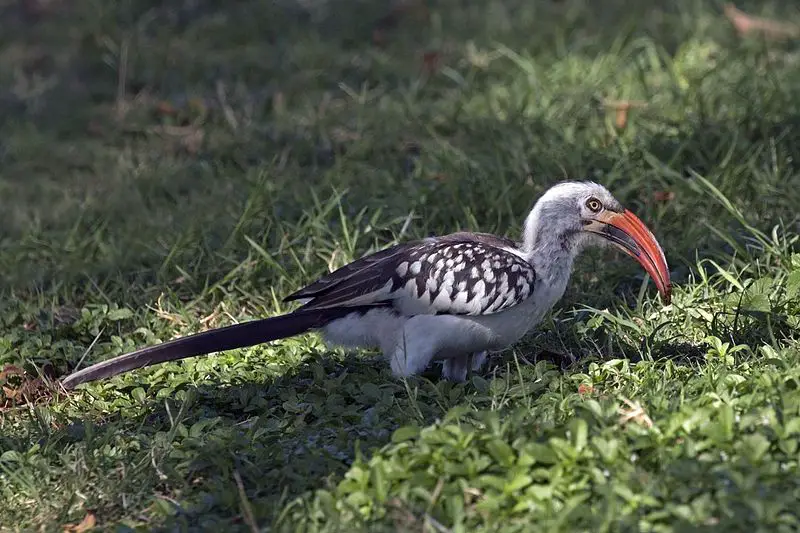
The Northern Red-billed Hornbill is a species of bird belonging to the Bucerotidae family. It can be found in many countries across Africa, from Mauritania through Somalia and Northeast Tanzania.
This hornbill has five recognized subspecies, though all were once considered part of one single species. The northern red-billed hornbill have distinctive black feathers on their body with deep yellow around its eyes and crest.
Its bill and legs are bright red while they feature an impressive casque at the top of it’s head that helps amplify calls during mating season or as a signifier for territoriality towards other birds.
They feed mainly on fruits such as figs but also enjoy insects like moths or beetles when available.Scientific classification:
| Kingdom | Animalia |
| Phylum | Chordata |
| Class | Aves |
| Order | Bucerotiformes |
| Family | Bucerotidae |
| Genus | Tockus |
| Species | T. erythrorhynchus |
Also Featured In: Common Nigerian Birds,
2. Egyptian Goose
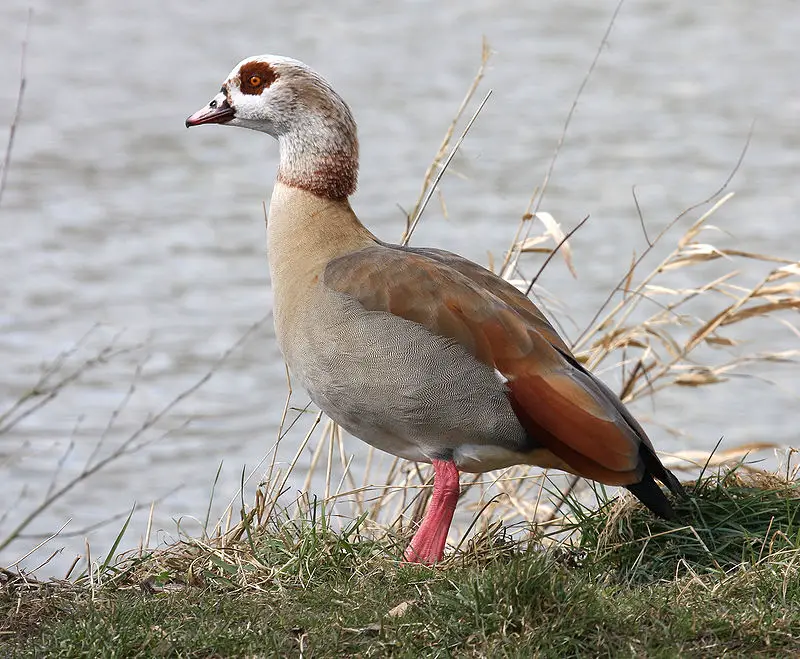
The Egyptian goose is a beautiful bird from the Anatidae family native to Africa. It has long been revered by the Ancient Egyptians, who depicted it in much of their artwork.
Today, these geese are kept as ornamental birds and commonly escape into the wild, resulting in an abundance of feral populations across southern Sahara and Nile Valley regions.
With its grayish-brown body featuring white patches around its neck and tail feathers that range from dark brown to bluish-grey coloration.
This species stands out amongst other waterfowls with its striking appearance which also features bold orange eyes surrounded by blue eye rings – quite remarkable.
As they swim along rivers or roam grasslands searching for food such as grains, fruits & vegetables; they make great additions to both aviary collections or natural habitats alike.Scientific classification:
| Kingdom | Animalia |
| Phylum | Chordata |
| Class | Aves |
| Order | Anseriformes |
| Family | Anatidae |
| Genus | Alopochen |
| Species | A. aegyptiaca |
Also Featured In: Egyptian Birds, Amsterdam Birds You Should Know
3. Lilac-Breasted Roller
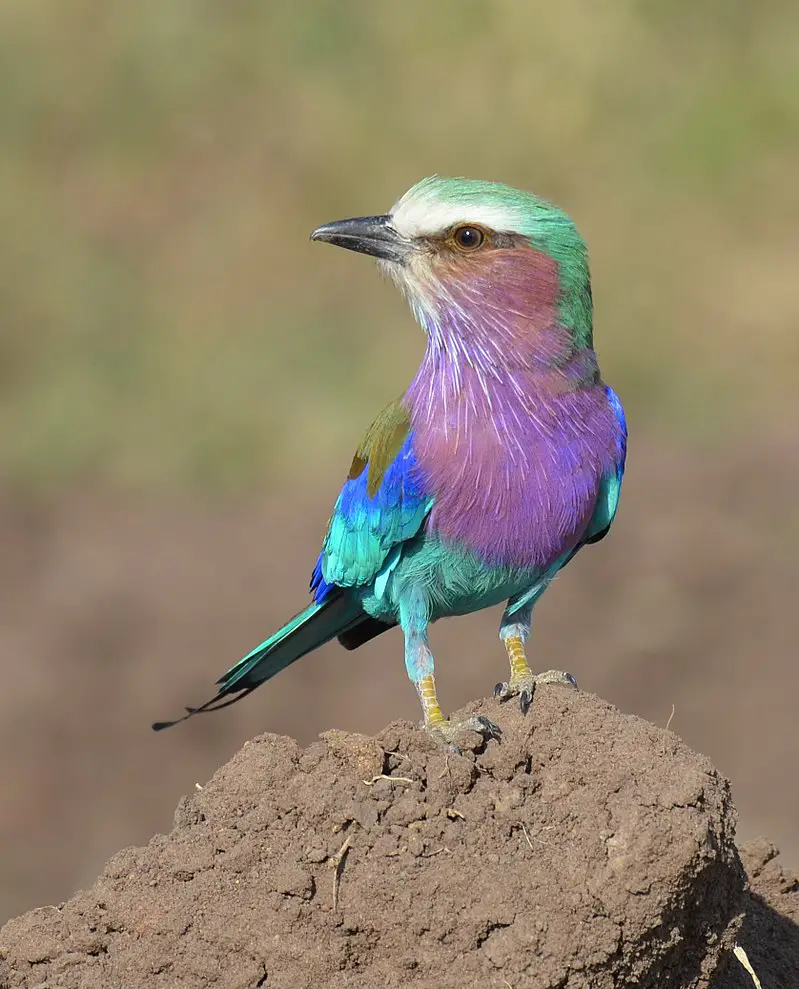
The Lilac-breasted Roller is a spectacular bird native to Southern and Eastern Africa, with occasional appearances in the southern Arabian Peninsula.
With its bright purple chest plumage and distinct black stripes on its wings and tail feathers, it stands out among birds of the same family.
It is usually found alone or in pairs perched atop trees or other high viewpoints, often used as lookout points for predators.
This species prefers open areas such as woodlands and savannas; it avoids treeless places like deserts due to their lack of protection from potential dangers.
Its call is loud and melodious – an unmistakable sound echoing through African skies.Scientific classification:
| Kingdom | Animalia |
| Phylum | Chordata |
| Class | Aves |
| Order | Coraciiformes |
| Family | Coraciidae |
| Genus | Coracias |
| Species | C. caudatus |
Also Featured In: Birds of Tanzania, Famous Paintings Birds
4. Superb Starling
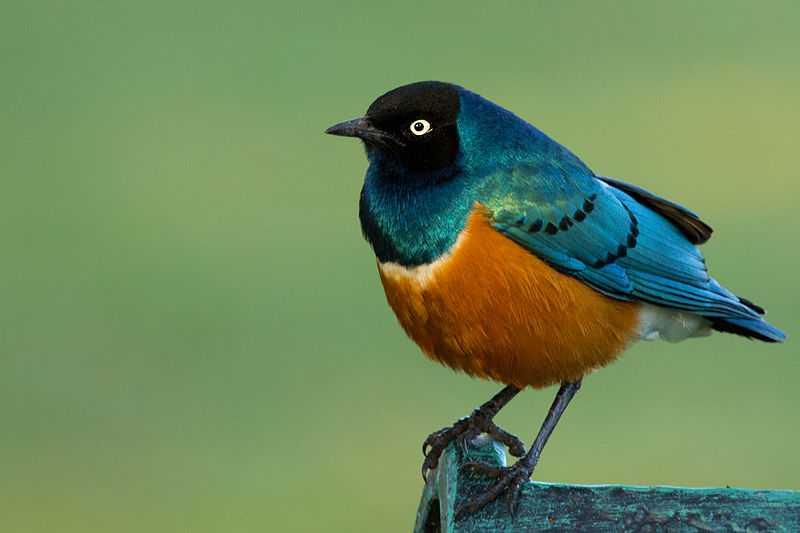
The Superb Starling is an impressive bird native to East Africa. It belongs to the starling family and was previously known as Spreo superbus.
This species can be found in Ethiopia, Somalia, Uganda, Kenya, South Sudan and Tanzania living in savanna areas with thornbush and acacia trees or near open woodlands or lakeshores.
Its plumage is mainly black with bright yellow patches on its wings while its bill is a distinctive grey-blue coloration.
The male has glossy blue feathers around his head giving him a distinguished look that stands out from other birds of this type.
In addition they possess long tails which make them great gliders when soaring through their habitats looking for food such as insects, crops or small animals like frogs and lizards to eat.Scientific classification:
| Kingdom | Animalia |
| Phylum | Chordata |
| Class | Aves |
| Order | Passeriformes |
| Family | Sturnidae |
| Genus | Lamprotornis |
| Species | L. superbus |
5. Kori Bustard
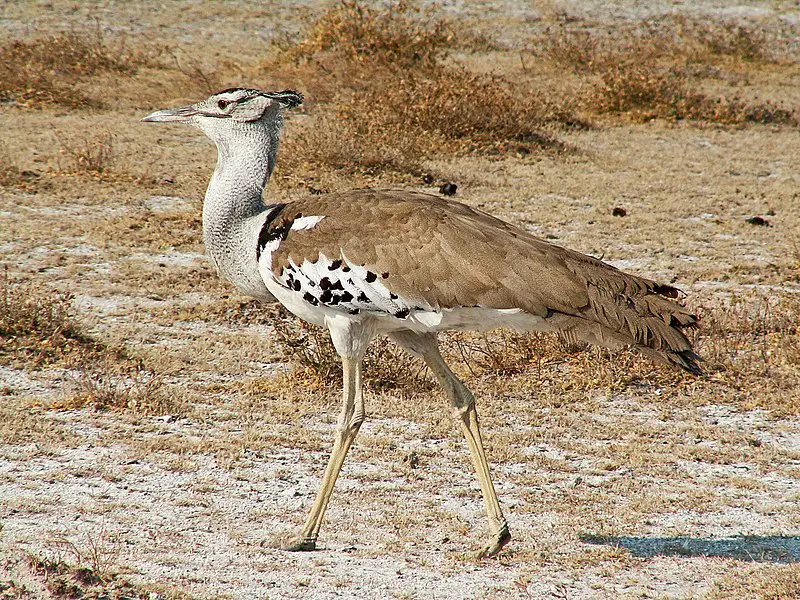
The Kori Bustard is the largest flying bird native to Africa and part of the bustard family. It has a large body, with males reaching up to 20kg in weight – making it one of the heaviest living animals capable of flight.
Its range covers most African countries from Ethiopia all the way down south towards South Africa.
The Kori Bustard is omnivorous and feeds on insects, small lizards, seeds, fruit and even carrion if available.
Their feathers are mostly brownish grey while their heads have black stripes running over them which makes them easily identifiable when seen in its natural habitat.
They usually live alone or in pairs during breeding season but will gather into larger groups at other times throughout their lives; typically nesting on dry open grasslands near water sources for easy access to food and drink.Scientific classification:
| Kingdom | Animalia |
| Phylum | Chordata |
| Class | Aves |
| Order | Otidiformes |
| Family | Otididae |
| Genus | Ardeotis |
| Species | A. kori |
Also Featured In: Birds of Etosha National Park, Large African Birds You Need to Know
6. Yellow-Billed Stork
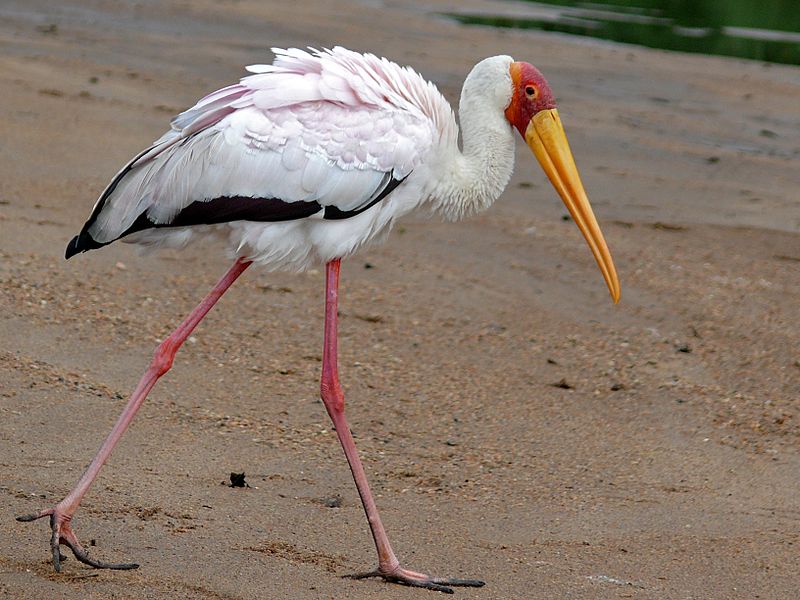
The yellow-billed stork is a large wading bird found in Africa south of the Sahara as well as Madagascar.
It belongs to the family Ciconiidae and has three other species in its genus – Mycteria americana, Mycteria cinerea and Leptoptilos javanicus.
This majestic bird stands at an average height of up to 1 meter with a wingspan that can reach 2 meters wide.
Its plumage is predominantly white with black flight feathers that contrast against its bright yellow bill for which it is named after.
The Yellow-billed Stork feeds on fish, frogs, insects and small reptiles like snakes by probing deep into mud or shallow water bodies using its long beak.
These captivating birds are also known to form colonies during their nesting season from August until October where they build nests out of sticks atop tall trees near wetlands or riversides.Scientific classification:
| Kingdom | Animalia |
| Phylum | Chordata |
| Class | Aves |
| Order | Ciconiiformes |
| Family | Ciconiidae |
| Genus | Mycteria |
| Species | M. ibis |
Also Featured In: Fuerteventura Island Birds You Need to See,
7. African Jacana
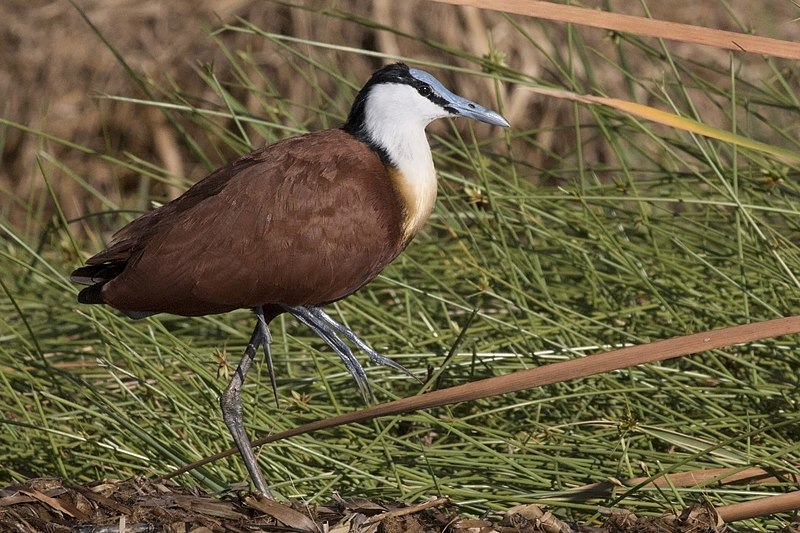
The African Jacana is a charming wader belonging to the family of Jacanidae, mostly found in sub-Saharan Africa.
It has long toes and claws that allow it to walk on floating vegetation in shallow lakes which form its preferred habitat.
The bird was officially described by Johann Friedri in 1789 with an interesting origin and pronunciation for its name -Jacanidae.
This aquatic bird is known for its striking plumage features like yellow crowns and black wings marked with chestnut brown stripes across them, making them look even more attractive when they spread their wing feathers during courtship displays.
They feed mainly on insects, tadpoles, frogs etc., skimming nearby water surface or plucking prey from vegetation as they wander around these wetlands areas.Scientific classification:
| Kingdom | Animalia |
| Phylum | Chordata |
| Class | Aves |
| Order | Charadriiformes |
| Family | Jacanidae |
| Genus | Actophilornis |
| Species | A. africanus |
Also Featured In: Birds of Côte d’Ivoire,
8. White-Backed Vulture
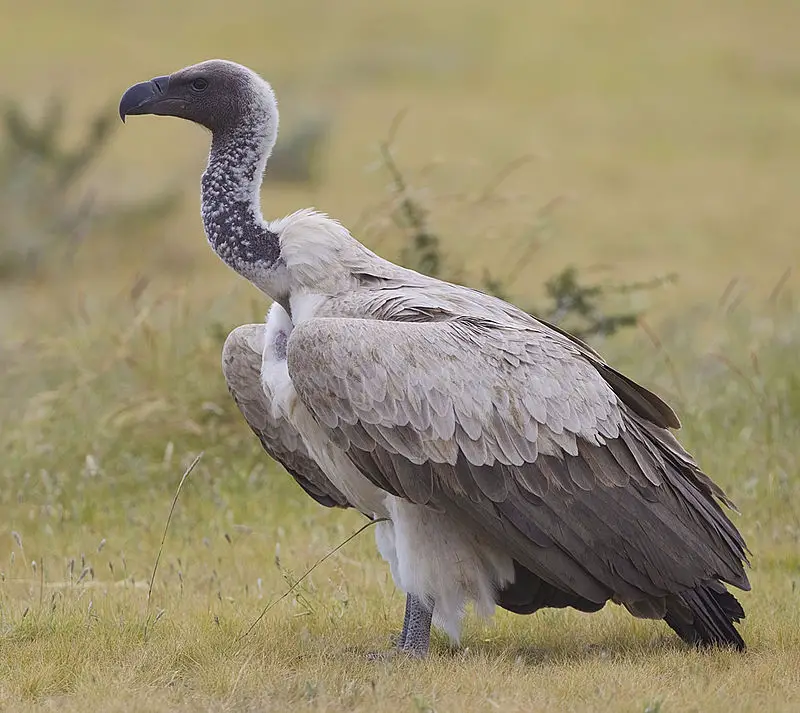
The White-backed Vulture, or Gyps africanus, is a species of Old World vultures that inhabits the African continent.
It has distinct features including down feathers on its head and neck as well as white ruff around its neck. Its wings are broad and its tail short.
This distinctive bird is primarily found in open habitats such as grasslands, savannahs, woodlands and wetlands where it feeds mainly on carrion from animals like wildebeests and zebras killed by other predators.
The White-backed Vulture plays an important role in maintaining balance within the food chain by helping to clean up carcasses left behind by larger carnivores which helps to reduce diseases caused by decaying matter while providing vital nutrients for scavenging birds like itself.Scientific classification:
| Kingdom | Animalia |
| Phylum | Chordata |
| Class | Aves |
| Order | Accipitriformes |
| Family | Accipitridae |
| Genus | Gyps |
| Species | G. africanus |
9. Crowned Lapwing
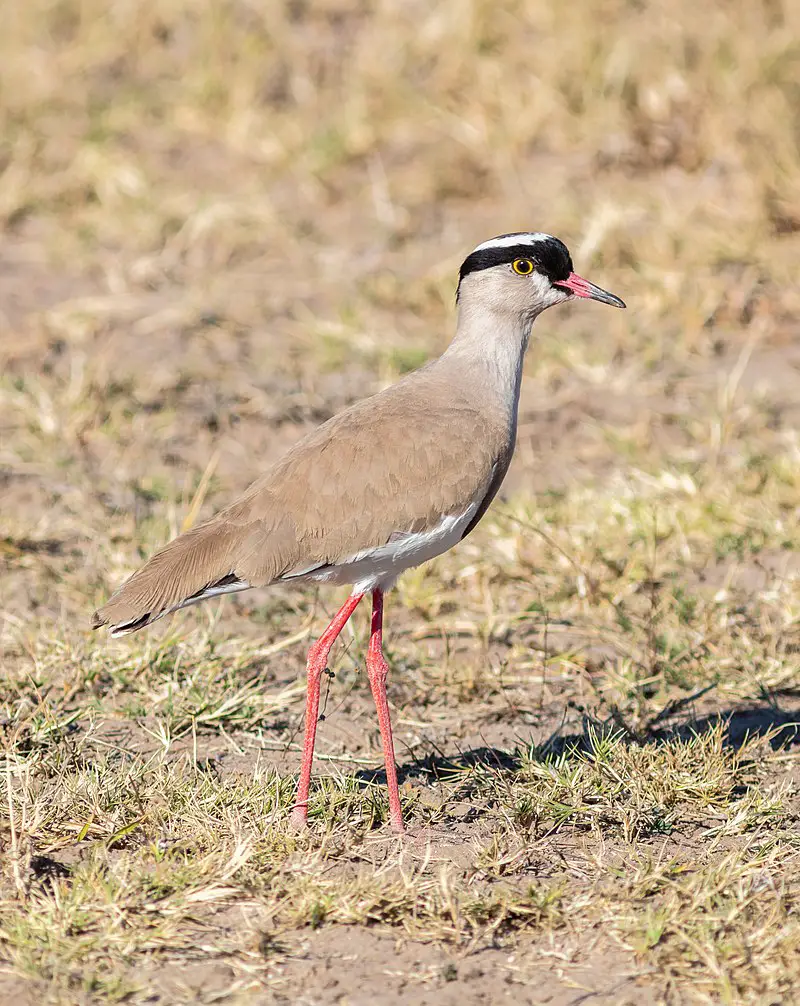
The crowned lapwing is a striking bird of the subfamily Vanellinae, found in many parts of Africa. Their most distinctive feature is their bright and attractive crown-shaped crest on the head.
They typically have brown plumage with white spots over the wings and tail, as well as yellow legs and beaks.
These birds are known for being quite vocal; they make loud calls to communicate between one another or warn predators away from their nests.
Crowned lapwings can live up to 10 years in captivity but usually only survive 1–2 years in the wild due to predation by other animals such as cats, dogs, snakes and hawks.
Despite this mortality rate these birds remain common throughout much of Africa thanks to their adaptability and ability nest near humans without conflict.Scientific classification:
| Kingdom | Animalia |
| Phylum | Chordata |
| Class | Aves |
| Order | Charadriiformes |
| Family | Charadriidae |
| Genus | Vanellus |
| Species | V. coronatus |
10. Grey Crowned Crane

The Grey Crowned Crane is a beautiful bird native to eastern and southern Africa. It belongs to the crane family, Gruidae, and its stunning plumage consists of grey feathers topped with golden crowns on their heads.
This species has become Uganda’s national bird due to its gracefulness in flight as well as for being an important part of local cultures across the continent.
The Grey Crowned Crane stands out from other birds not only because of its colorful appearance but also because it performs elaborate mating dances involving leaps, bows, throwing their head back or flapping wings while calling loudly – all in an effort to attract a mate.
In addition to these displays they are highly social animals that form strong bonds with one another and can live up 20 years if given proper care.Scientific classification:
| Kingdom | Animalia |
| Phylum | Chordata |
| Class | Aves |
| Order | Gruiformes |
| Family | Gruidae |
| Genus | Balearica |
| Species | B. regulorum |
Also Featured In: Birds of South African, Big Birds that Live in Uganda
11. Hornbill
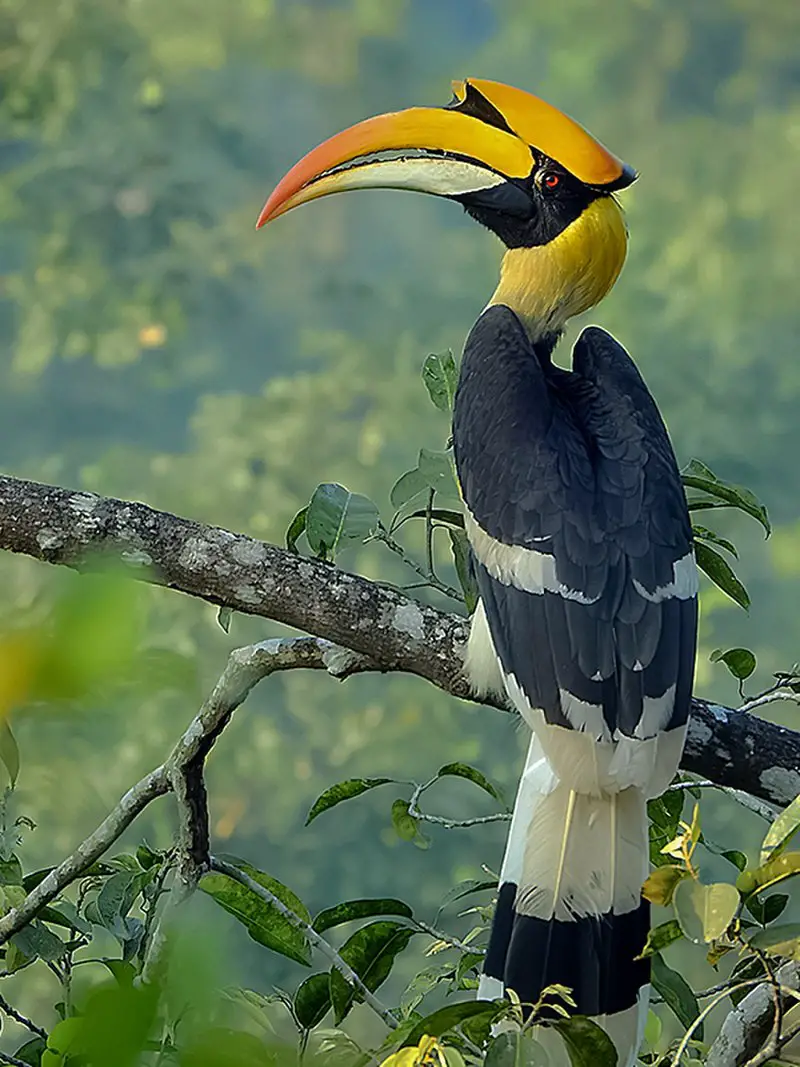
Hornbills are a tropical and subtropical bird species with characteristic long, curved bills. Their English and scientific names both refer to the shape of their bill which resembles that of a cow’s horn.
They have strong beaks for cracking open hard-shelled fruits as well as powerful wings for flying between trees or over great distances in search of food or mates.
Hornbills also feature beautiful plumage ranging from white to black feathers with yellow, brown, red and blue accents on the head, neck and back areas depending on the species.
In addition they often display brightly coloured casques – helmet like structures – atop their upper mandible adding further visual appeal to these majestic birds.Scientific classification:
| Kingdom | Animalia |
| Phylum | Chordata |
| Class | Aves |
| Order | Bucerotiformes |
| Family | Bucerotidae Rafinesque, 1815 |
Also Featured In: Birds That Live in the Jungle, Common Birds in the Cities
12. Weavers
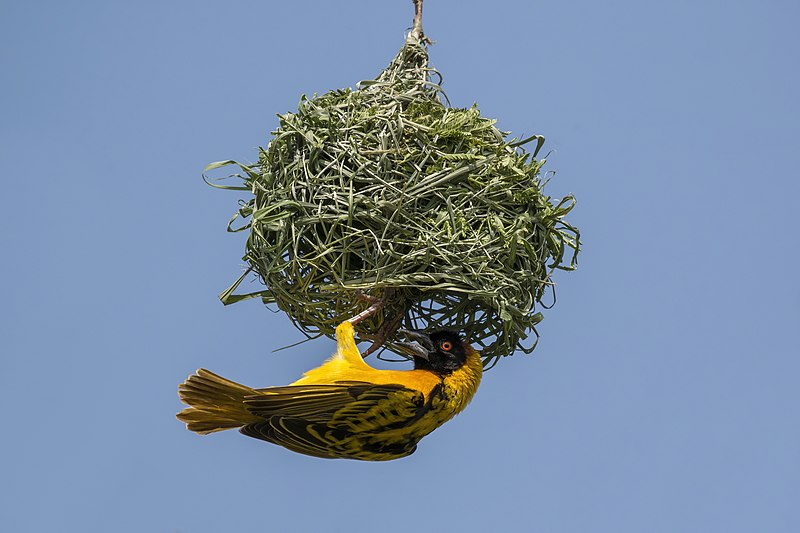
Weaver birds are small passerine birds found in the family Ploceidae. They are known for their intricately woven nests, made from vegetation and other materials sourced locally by the weavers.
These complex structures have earned them their distinctive name, as they appear to weave together a home away from home.
Weaverbirds come in a range of sizes and colours – some are brightly coloured while others may be more subtle or plainer looking – but all share an affinity with weaving material into intricate architectural designs.
Some species also use mud instead of plant life to build these impressive homes. Not only do these feathered architects give us insight into nature’s incredible capacity for problem-solving and resourcefulness; they provide stunningly colourful displays too.Scientific classification:
| Kingdom | Animalia |
| Phylum | Chordata |
| Class | Aves |
| Order | Passeriformes |
| Superfamily | Passeroidea |
| Family | Ploceidae Sundevall, 1836 |
13. Grey Go-Away-Bird
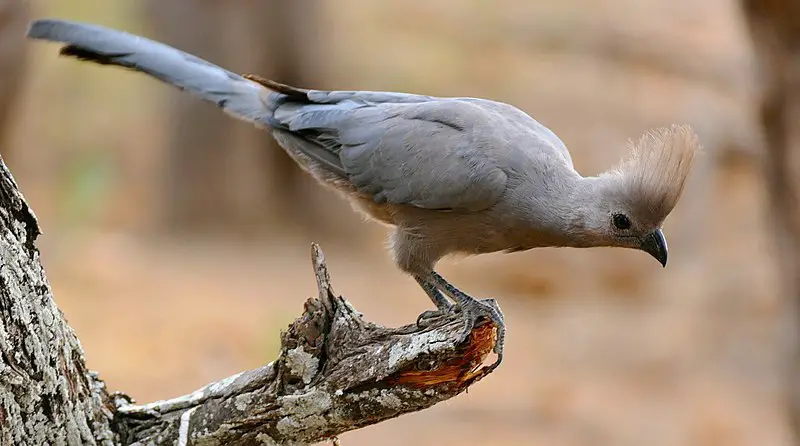
The Grey Go-Away-Bird is a beautiful and vibrant bird native to the southern Afrotropics. It has grey feathers on its body with white edging, making it distinct from other birds in its area.
These bold birds can be seen foraging for food high up in trees or dust bathing on the ground in groups or parties.
When disturbed they make their presence known by producing loud cackling calls that sound like “go away”.
This species of bird prefers arid to moist open woodlands and thorn savanna near surface water which provides them with plenty of opportunities to search for food such as insects and fruits.
All in all, the Grey Go-Away-Bird is an interesting member of the avian community.Scientific classification:
| Kingdom | Animalia |
| Phylum | Chordata |
| Class | Aves |
| Order | Musophagiformes |
| Family | Musophagidae |
| Genus | Corythaixoides |
| Species | C. concolor |
Also Featured In: Johannesburg Birds You Need to Know,
14. Southern Yellow-Billed Hornbill
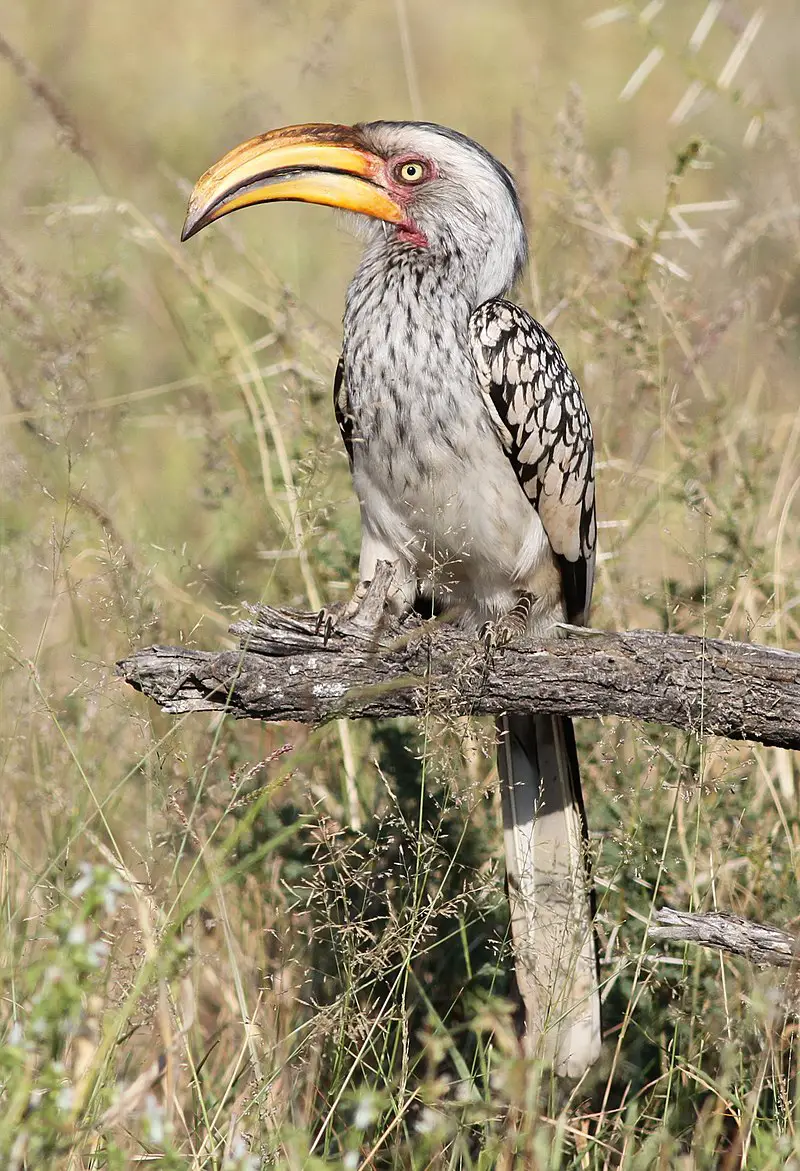
The Southern yellow-billed hornbill is a species of medium sized bird found in southern Africa. It feeds mainly on the ground, foraging for seeds, insects, spiders and scorpions.
These birds are quite common and can be seen along roadsides and water courses due to their preference of dry thornveldt as well as broad-leafed woodlands.
They have bright yellow bills which make them easily recognizable among other birds.
The average length of these beautiful creatures range between 40 – 48 cm with an impressive wingspan reaching up to 90 cm wide.
This stunning species is considered vulnerable by IUCN since it’s numbers are slowly declining due to hunting activities and habitat destruction from urbanization.Scientific classification:
| Kingdom | Animalia |
| Phylum | Chordata |
| Class | Aves |
| Order | Bucerotiformes |
| Family | Bucerotidae |
| Genus | Tockus |
| Species | T. leucomelas |
15. Saddle-Billed Stork
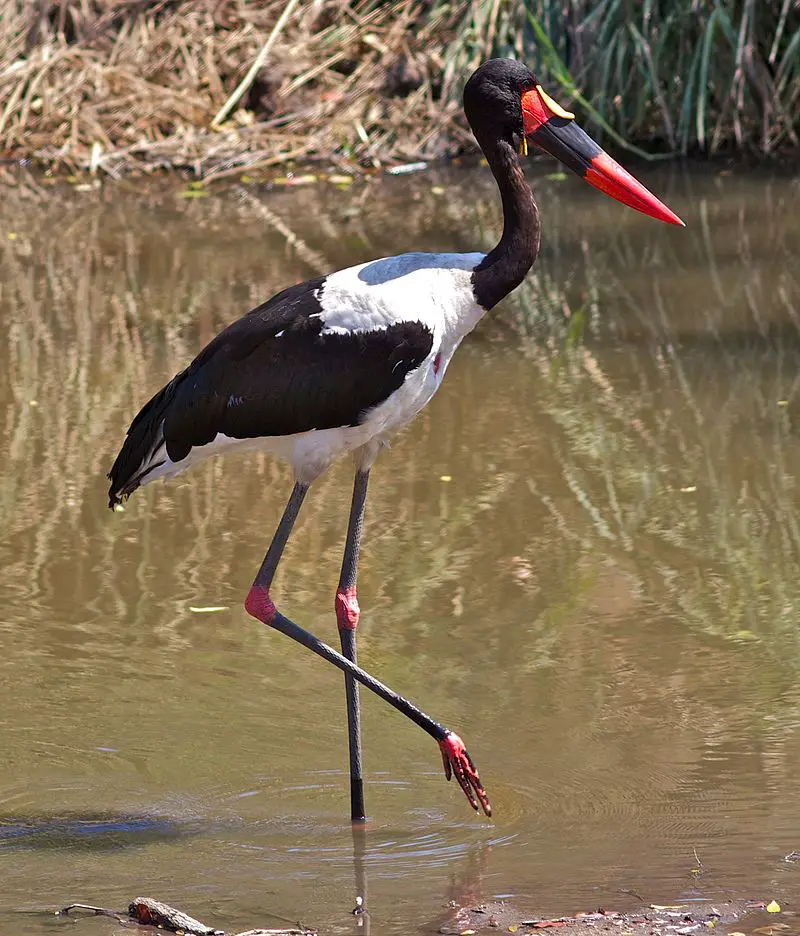
The Saddle-billed Stork is a large wading bird from the stork family, Ciconiidae. It can be found in sub-Saharan Africa and some parts of western Africa.
This majestic bird stands out with its striking features – it has an impressive bill that looks like a saddle and bright red legs which contrast against its white plumage on top.
The Saddle-billed Stork’s diet consists mostly of fish, frogs, aquatic invertebrates as well as small reptiles or mammals they come across while scavenging for food in wetland areas.
Sadly, this species is considered endangered in South Africa due to habitat loss and degradation caused by human activities such as drainage projects and agricultural expansion.
We must take action to protect these beautiful creatures before their numbers decrease further.Scientific classification:
| Kingdom | Animalia |
| Phylum | Chordata |
| Class | Aves |
| Order | Ciconiiformes |
| Family | Ciconiidae |
| Genus | Ephippiorhynchus |
| Species | E. senegalensis |
Also Featured In: Large Birds of Uganda,
16. Cape Teal
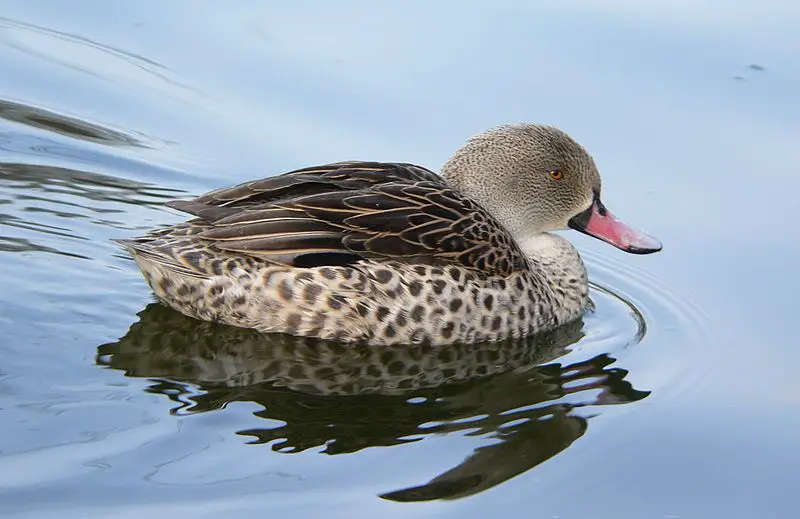
The Cape Teal is a medium-sized dabbling duck native to sub-Saharan Africa. Measuring between 44 and 46 centimetres in length, it has a distinctive black head with white eye patches, along with greenish wings and chestnut sides.
It feeds on aquatic invertebrates and plants found in wetlands such as marshes, lagoons, estuaries and rivers.
The species was first described by German naturalist Johann Friedrich Gmelin in 1789 – he placed it within the genus Anas alongside ducks, geese and swans.
This beautiful bird can be seen near water bodies all across its range where suitable habitat exists for them to thrive.Scientific classification:
| Kingdom | Animalia |
| Phylum | Chordata |
| Class | Aves |
| Order | Anseriformes |
| Family | Anatidae |
| Genus | Anas |
| Species | A. capensis |
17. Southern Ground Hornbill
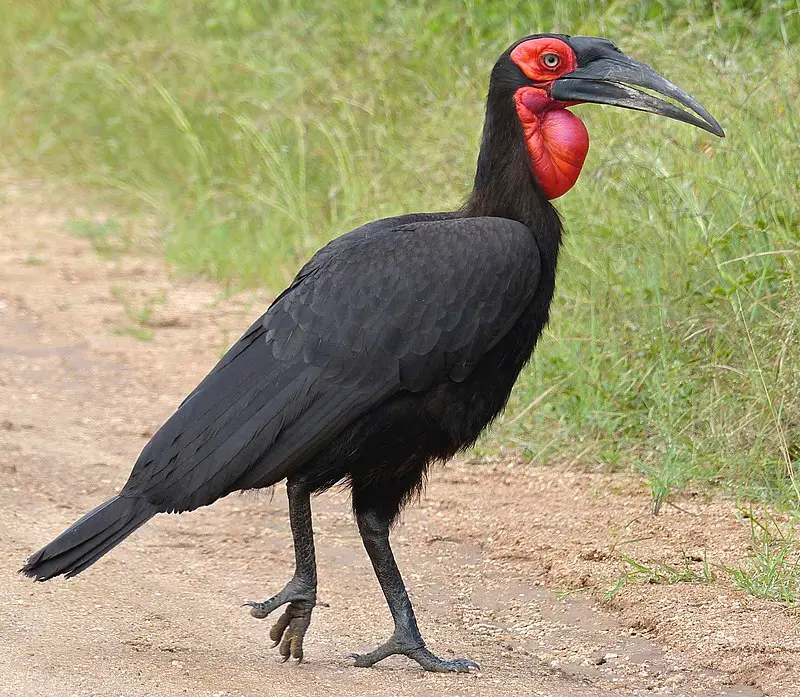
The Southern Ground Hornbill is a majestic bird, native to the southern regions of Africa such as Kenya and South Africa. It inhabits both woodlands and savannas where it can be found in abundance.
These birds are quite large, making them the largest species within their order worldwide. They have striking black feathers with red patches on their neck and wings which make for an impressive sight when taking flight.
A unique feature of these birds is that they form long-term pairs or family groups; usually consisting of two adults plus several helper offspring from previous years who assist in raising new young chicks together.
This amazing creature’s powerful presence remains unchanged throughout its range – reminding us why conservation efforts must persist if we want this incredible bird to remain part of our planet’s diverse wildlife heritage for centuries to come.Scientific classification:
| Kingdom | Animalia |
| Phylum | Chordata |
| Class | Aves |
| Order | Bucerotiformes |
| Family | Bucorvidae |
| Genus | Bucorvus |
| Species | B. leadbeateri |
Also Featured In: Common Kenyan Birds,
18. Marabou Stork
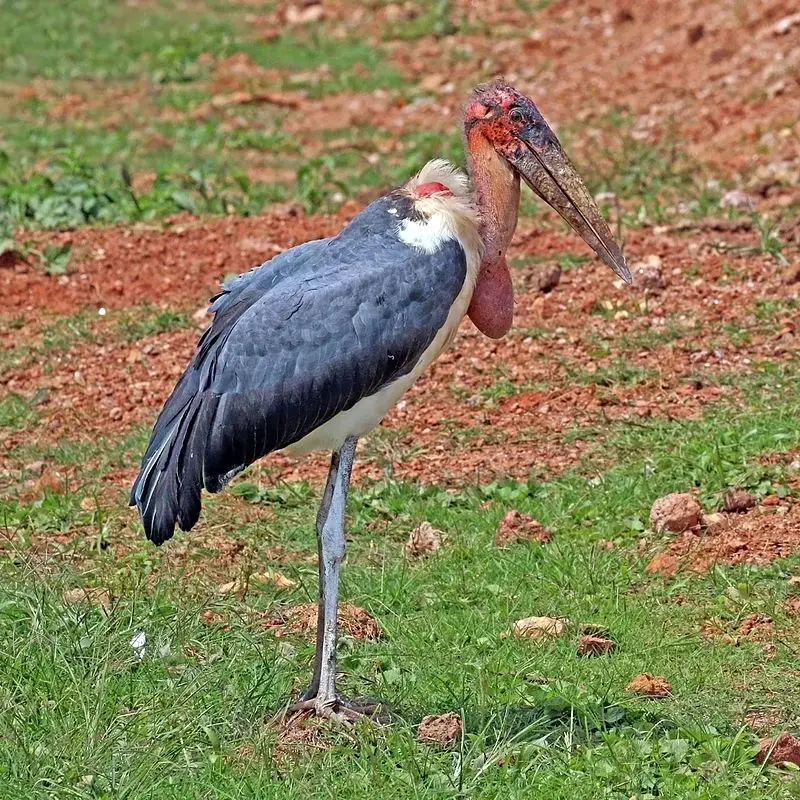
The marabou stork is a large wading bird native to sub-Saharan Africa. It has an unmistakable appearance, with cloak-like wings and back, skinny white legs and sometimes a large mass of “hair”.
They reside in both wet and arid habitats near human habitation, often found at landfill sites.
This species has earned the nickname ‘undertaker bird’ due to its unique shape viewed from behind.
Despite living alongside humans they remain elusive birds who rarely interact with us but can still be seen gliding on thermals or standing majestically by lakesides.
The marabou stork is truly an impressive sight that will stay in your memory forever.Scientific classification:
| Kingdom | Animalia |
| Phylum | Chordata |
| Class | Aves |
| Order | Ciconiiformes |
| Family | Ciconiidae |
| Genus | Leptoptilos |
| Species | L. crumenifer |
19. Yellow-Billed Oxpecker
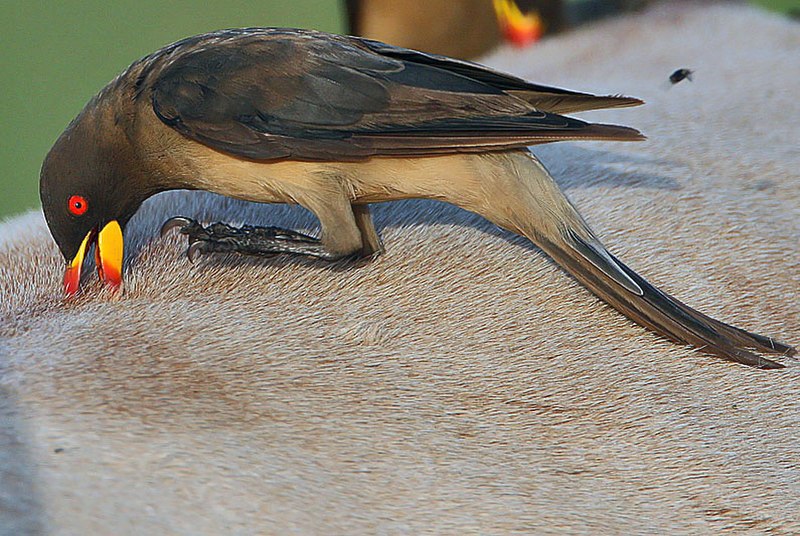
The Yellow-billed Oxpecker is a passerine bird native to the savannahs of Sub-Saharan Africa. It was previously placed in the starling and myna family, Sturnidae.
These birds are characterized by their bright yellow bills, which give them their name.
They feed mainly on insects found on large mammals such as wildebeests and zebras, but also consume fruits from nearby trees or shrubs when available.
The species tends to dominate over its smaller relative -the Red-billed oxpecker – whenever they share feeding grounds together; although it is least common in eastern parts of its range where they overlap with each other’s territories.
All in all, this beautiful avian creature makes for an interesting sight while exploring the African Savannah.Scientific classification:
| Kingdom | Animalia |
| Phylum | Chordata |
| Class | Aves |
| Order | Passeriformes |
| Family | Buphagidae |
| Genus | Buphagus |
| Species | B. africanus |
Also Featured In: Uganda Birds Species, Birds that Ngorongoro Crater
20. Bucorvus
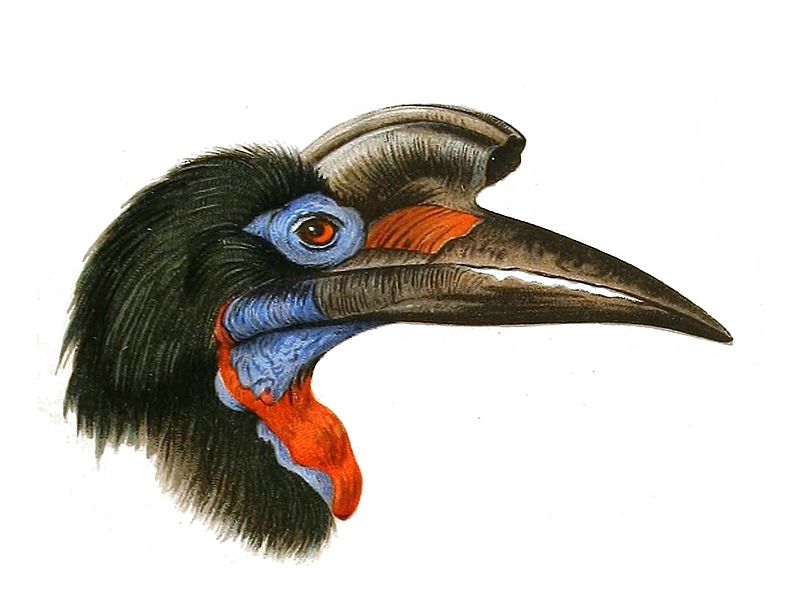
Bucorvus is a species of large bird from the family Bucorvidae, endemic to sub-Saharan Africa. They are approximately 1m tall and both species have black feathers with patches of red or purple on their wings and neck.
The Abyssinian ground hornbill occurs in a belt from Senegal east to Ethiopia while the southern ground hornbill lives in Southern and East Africa.
Ground Hornbills are omnivorous birds that feed mainly on insects, snakes, lizards, small mammals as well as fruits like figs.
They also build nests high up in trees which they line with mud for insulation before laying eggs inside them.
Their legs are very long allowing them to walk over distances looking for food sources easily compared to other avian speciesScientific classification:
| Kingdom | Animalia |
| Phylum | Chordata |
| Class | Aves |
| Order | Bucerotiformes |
| Family | Bucorvidae Bonaparte, 1854 |
| Genus | Bucorvus Lesson, 1830 |
Also Featured In: Endemic Ethiopian Birds You don’t Know,
21. Little Bee-Eater
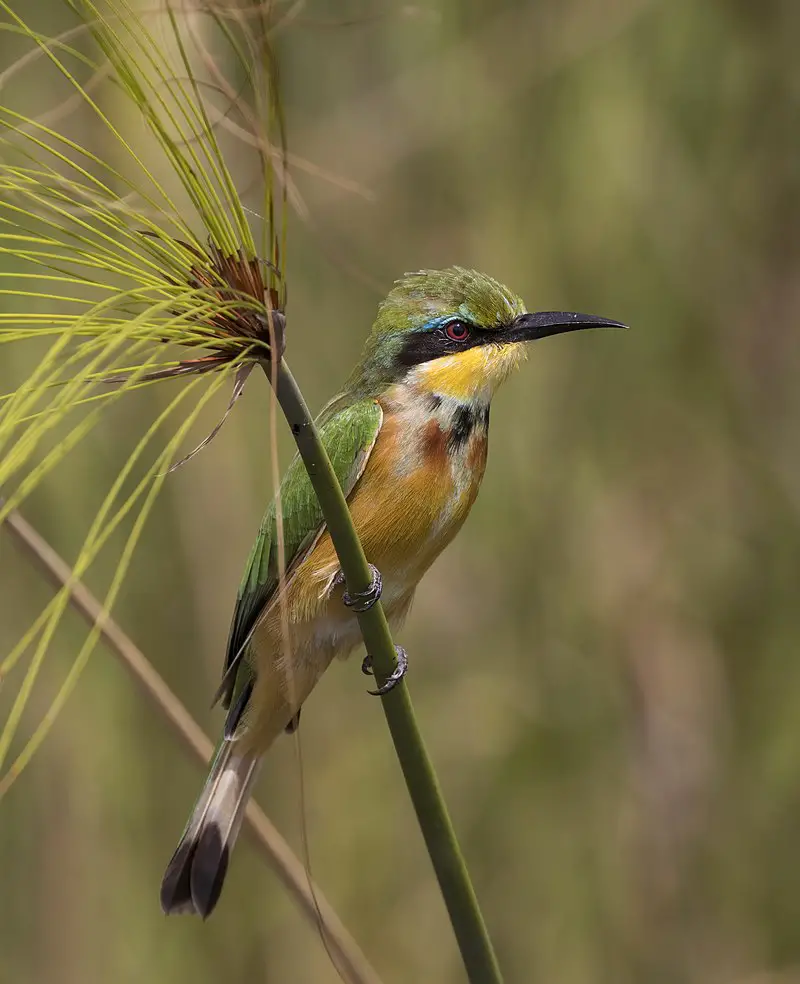
The Little Bee-eater (Merops pusillus) is a beautiful species of bird belonging to the family Meropidae.
These birds are found in much of Sub-Saharan Africa and their migration patterns depend on seasonal rainfall changes.
They have slender, brightly coloured bodies with an iridescent green sheen across the wings and back.
Their diet consists mainly of bees, wasps, dragonflies, moths and other insects which they catch mid-air or from perches above open grasslands or along mudbanks near water sources like rivers and lakes.
In order for these birds to digest their food properly before swallowing it whole, they use pebbles that help them grind up hard exoskeletons so as not to cause any blockages within their digestive tract – something only bee-eaters do.Scientific classification:
| Kingdom | Animalia |
| Phylum | Chordata |
| Class | Aves |
| Order | Coraciiformes |
| Family | Meropidae |
| Genus | Merops |
| Species | M. pusillus |
Also Featured In: Birds of Malawi,
22. Greater Flamingos
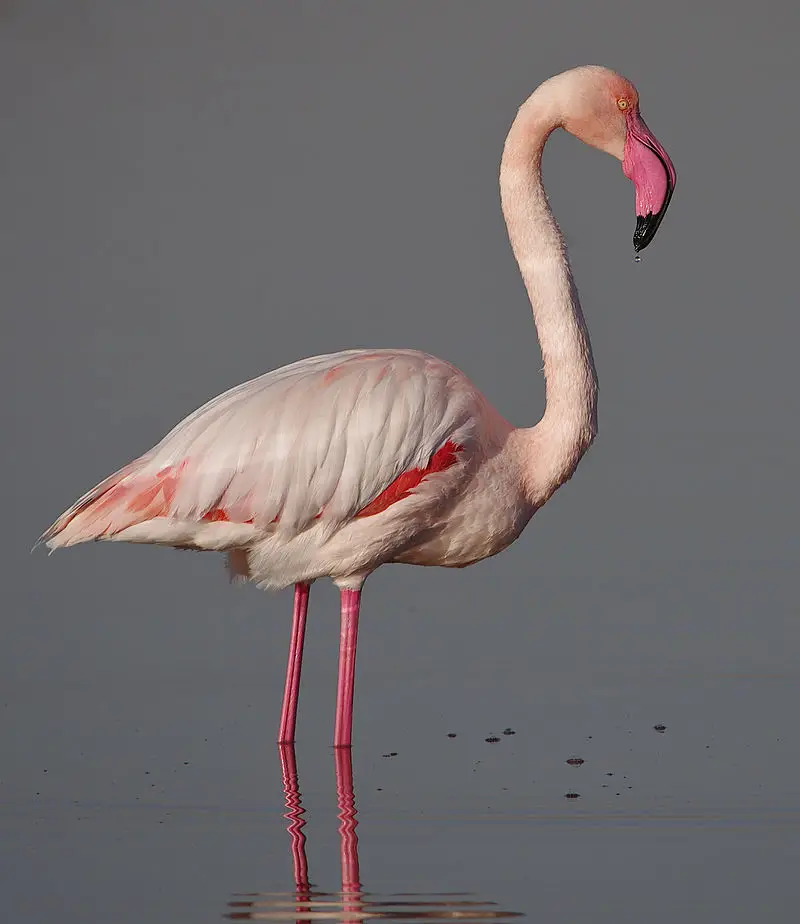
The Greater Flamingo (Phoenicopterus ruber) is the most widespread species of flamingos and can be found in parts of Europe, Africa, Asia and South America.
It has an unmistakable bright pink plumage that stands out against its white feathers. Its long legs are also a distinguishing feature as they reach up to 46 inches long.
The bill is curved downwards with a black tip at the end, which makes it easy for them to filter food from water sources like lakes or lagoons.
This diet mainly consists of small shrimp-like crustaceans called brine shrimp along with other aquatic insects and plants.
They also have salt glands on their tongues that help remove excess salt from ocean waters when they drink seawater as part of their regular diet.Scientific classification:
| Kingdom | Animalia |
| Phylum | Chordata |
| Class | Aves |
| Order | Phoenicopteriformes |
| Family | Phoenicopteridae |
| Genus | Phoenicopterus Linnaeus, 1758 |
Also Featured In: Most Common Birds Found in Chile,
23. Red-Billed Oxpecker
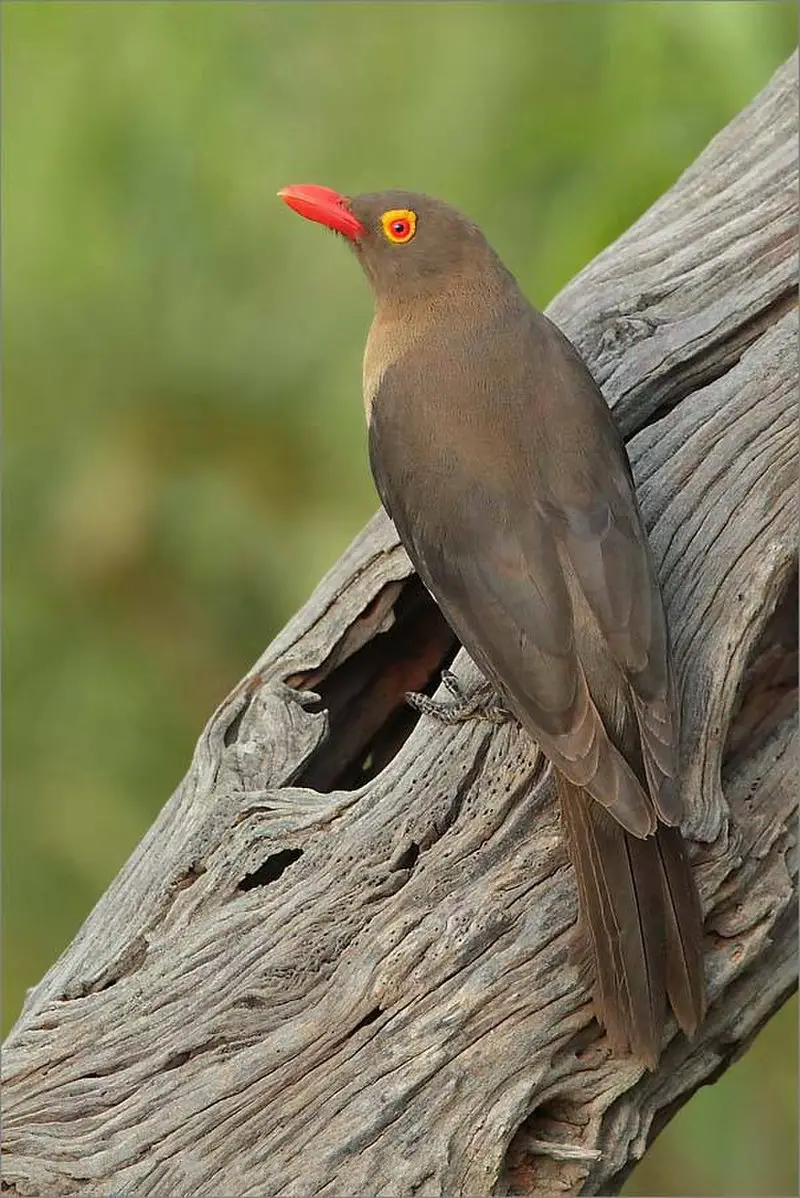
The red-billed oxpecker is a vibrant bird native to the savannas of sub-Saharan Africa. It has bright chestnut plumage, with distinctive yellow and black markings on its wings and tail.
The beak is a deep crimson color, for which it gets its name. These birds live in small flocks that often roost together at night or feed near large herds of animals such as zebra or wildebeest during the day.
They mainly eat ticks off these larger mammals but will also take advantage of any other food sources they can find such as fruits or insects.
Red-billed oxpeckers are known to have an important relationship with their prey; by removing parasites from them they help prevent diseases from spreading amongst different species in the area.Scientific classification:
| Kingdom | Animalia |
| Phylum | Chordata |
| Class | Aves |
| Order | Passeriformes |
| Family | Buphagidae |
| Genus | Buphagus |
| Species | B. erythrorynchus |
Also Featured In: Most common bird in Zambia,
24. Pin-Tailed Whydah
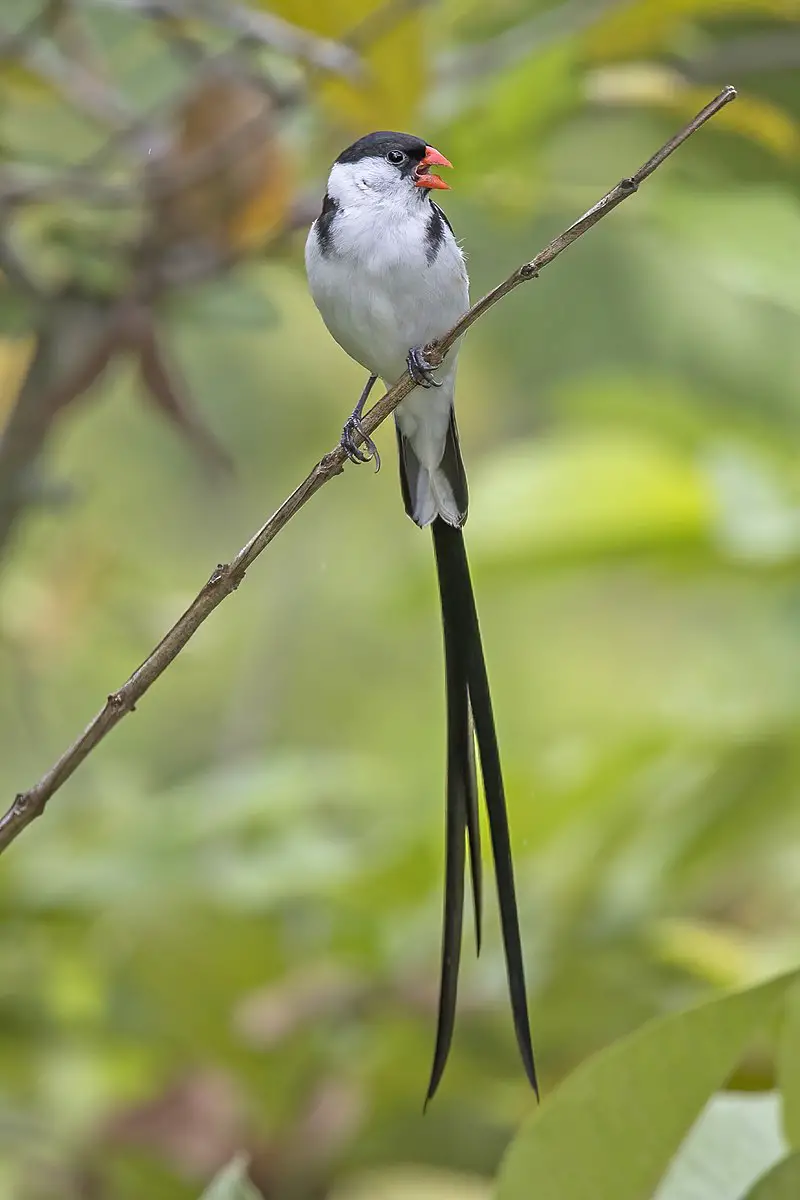
The Pin-tailed Whydah (Vidua macroura) is a small yet eye-catching songbird native to Africa, south of the Sahara Desert.
With breeding males sporting an impressive pennant-like tail, it measures in at 12–13 cm long and can be identified by its black plumage with white spots on wings and flanks.
It was first described by German naturalist Peter Simon Pallas back in 1764. The bird typically inhabits open savanna habitat where they feed mainly on grass seeds supplemented with insects during the rainy season.
During courtship displays, male birds will spread their tails while singing loudly from a perch or hover over females before mating takes place – making this one of nature’s most captivating spectacles.Scientific classification:
| Kingdom | Animalia |
| Phylum | Chordata |
| Class | Aves |
| Order | Passeriformes |
| Family | Viduidae |
| Genus | Vidua |
| Species | V. macroura |
Also Featured In: Birds of Senegal, Birds that You’ll Find in Puerto Rico
25. Red-Billed Firefinch
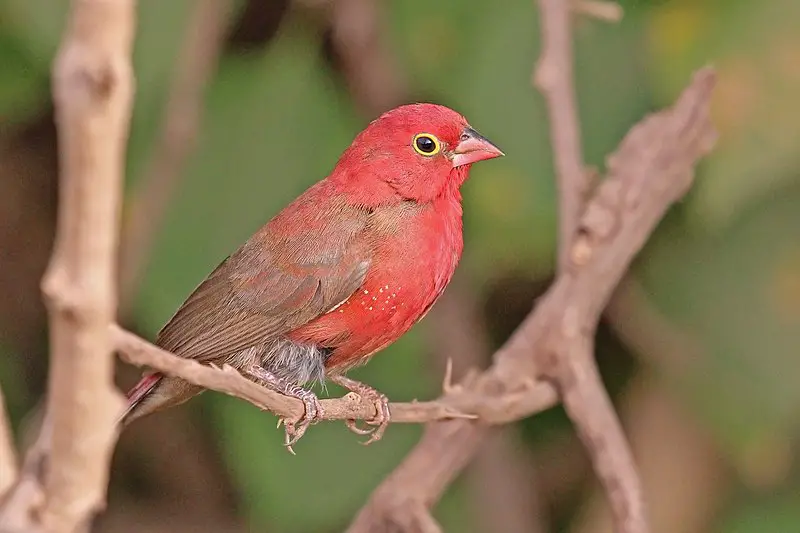
The Red-billed Firefinch is a small seed-eating bird native to sub-Saharan Africa. Its range spans an estimated 10 million square kilometers and it breeds year round in much of its habitat.
It has also been introduced, with mixed success, into both Egypt and southern Algeria where it continues to expand its population numbers.
The firefinch stands out from other birds with its bright colors – mostly black body plumage accented by red on the wings, tail feathers and most notably beak.
They are sociable creatures that can often be seen in flocks at waterholes or foraging together amongst vegetation for seeds.Scientific classification:
| Kingdom | Animalia |
| Phylum | Chordata |
| Class | Aves |
| Order | Passeriformes |
| Family | Estrildidae |
| Genus | Lagonosticta |
| Species | L. senegala |
26. Drongos
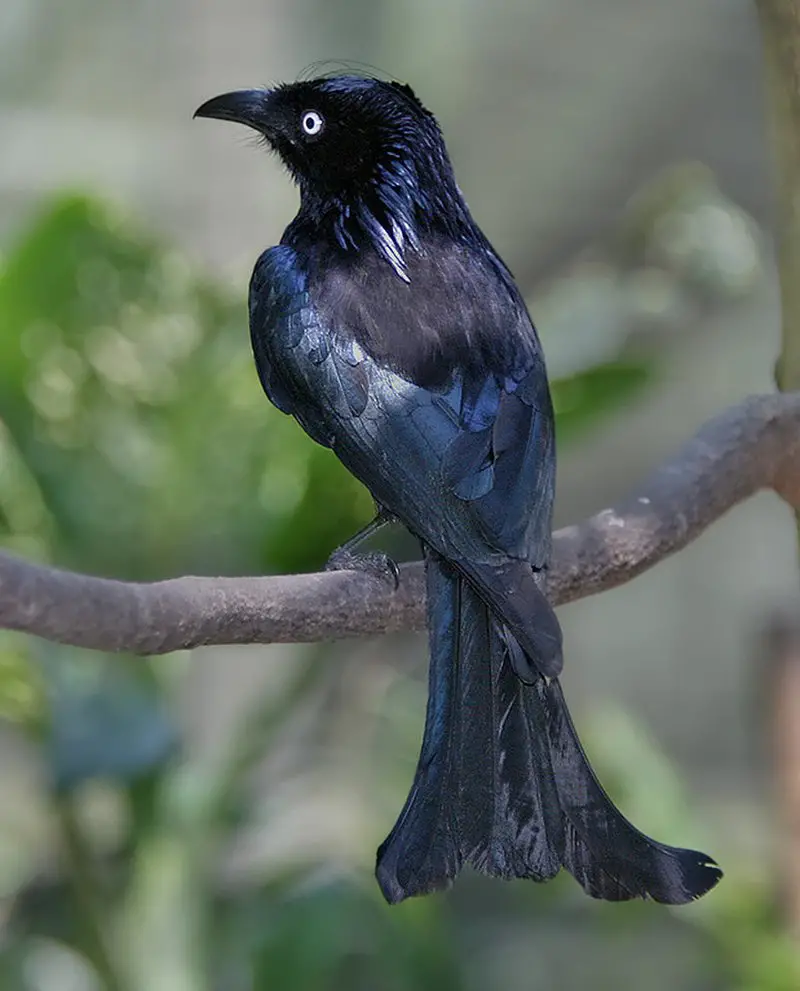
Drongos are an Old World tropical family of passerine birds belonging to the Dicruridae genus.
They have short legs, forked tails and a distinctive upright stance when perched.
Depending on the species they may be mostly black or dark grey in colour with some having elaborate tail decorations.
Drongos feed mainly on insects and small birds – catching them both in flight and from the ground.
They also sometimes eat fruit, nectar and even carcasses.
The drongo’s unique adaptations make it one of nature’s most successful hunters; able to survive almost anywhere in their natural range across Africa, Asia & Australia.Scientific classification:
| Kingdom | Animalia |
| Phylum | Chordata |
| Class | Aves |
| Order | Passeriformes |
| Superfamily | Corvoidea |
| Family | Dicruridae Vigors, 1825 |
| Genus | Dicrurus Vieillot, 1816 |
Also Featured In: Birds of United Arab Emirates, Common Uzbekistan Birds
27. Yellow-Headed Caracara
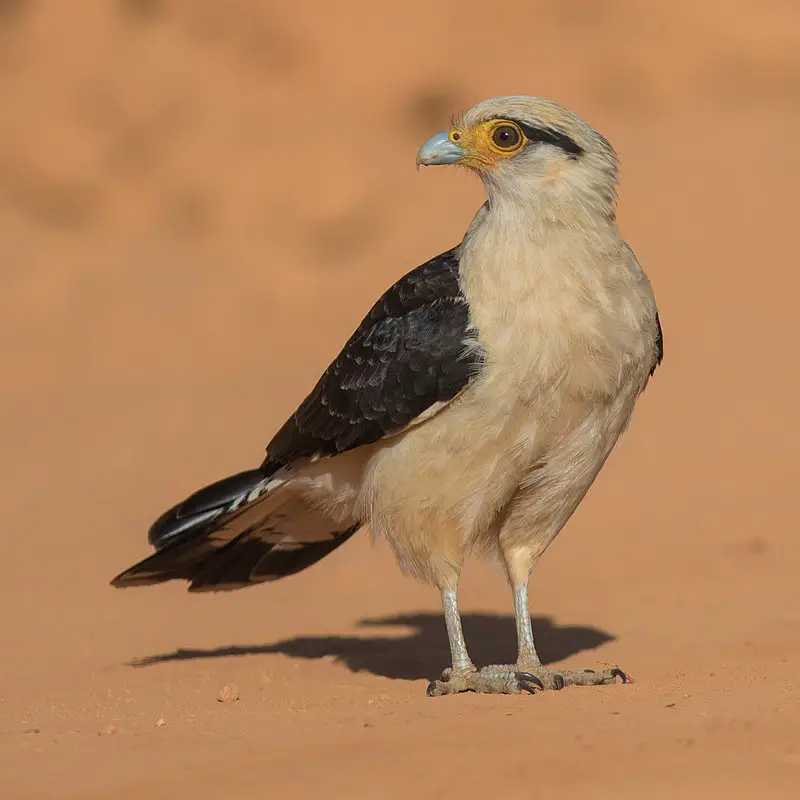
The Yellow-headed Caracara is a majestic bird of prey belonging to the Falconidae family, found in tropical and subtropical South America and southern parts of Central America.
It has an unmistakable bright yellow head that sets it apart from other birds. Unlike its cousins who specialize in fast aerial hunting, the caracara feeds on scavenged food such as dead animals or eggs instead.
Louis Jean Pierre Vieillot first described this species when he discovered them back in 1817. The size varies between 33 cm – 45 cm with wingspan ranging up to 90 cm long.
These stunning birds have a unique red face mask along with black & white plumage across their body which makes them very distinctive looking creatures indeed.Scientific classification:
| Kingdom | Animalia |
| Phylum | Chordata |
| Class | Aves |
| Order | Falconiformes |
| Family | Falconidae |
| Genus | Milvago |
| Species | M. chimachima |
Also Featured In: Most Common Birds In Paraguay,
28. Savanna Hawk
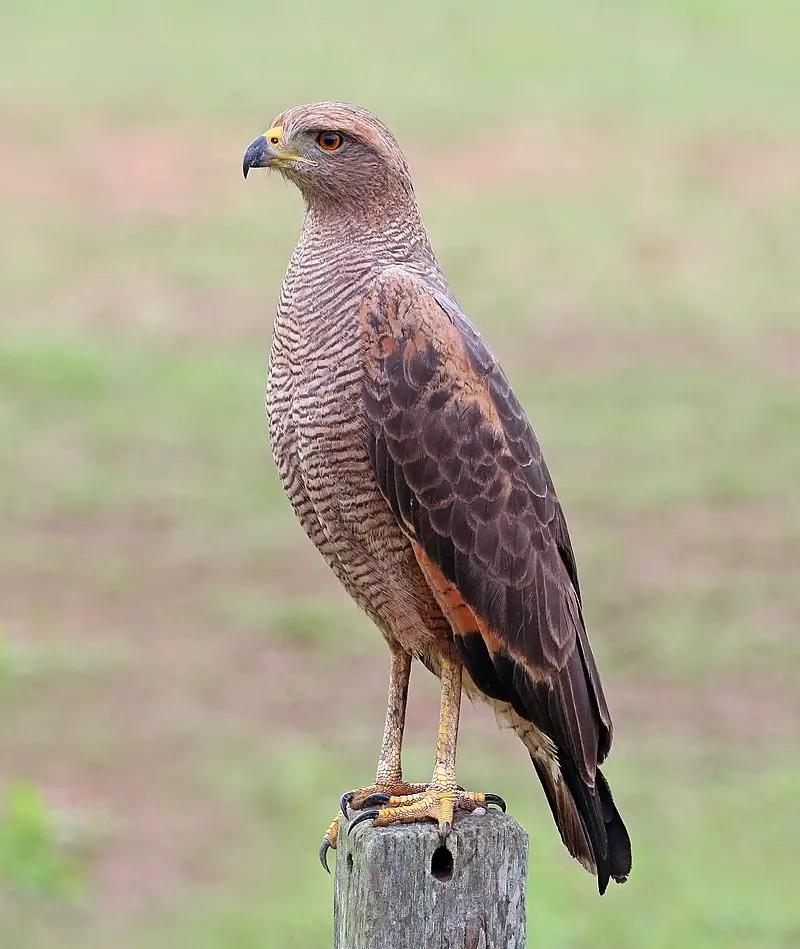
The Savanna Hawk is a large raptor found mainly in open savannas and swamp edges, ranging from Panama to Bolivia. It has an unmistakable rufous body with grey mottling above and fine black barring below.
Its length ranges between 46-61 cm (18-24 inches) with a weight of 845g (29.8oz).
These birds are fierce hunters who feed on small mammals, reptiles, amphibians or insects which they capture during flight using their powerful talons or beak.
They build nests high up in trees preferably along the edge of forests where they can spot prey easily over long distances due to their excellent vision capabilities.
The Savanna Hawk is known for its loud calls that echo through the skies as it soars across the landscape looking for its next meal.Scientific classification:
| Kingdom | Animalia |
| Phylum | Chordata |
| Class | Aves |
| Order | Accipitriformes |
| Family | Accipitridae |
| Genus | Buteogallus |
| Species | B. meridionalis |
Also Featured In: Most Common Birds in South America Birds,
29. Southern Masked Weaver
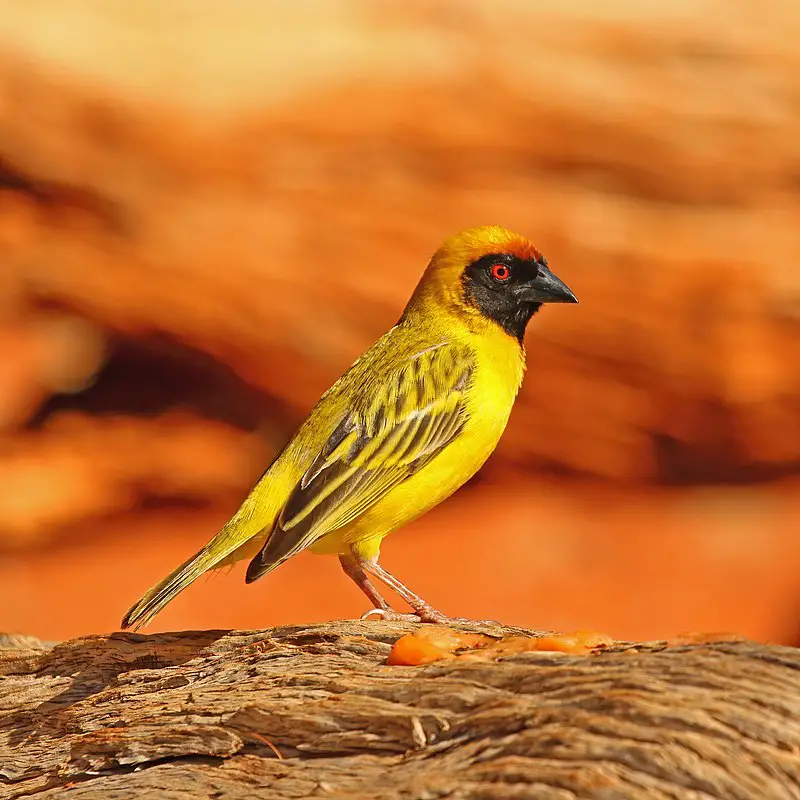
The Southern masked weaver is an incredibly widespread bird species commonly found throughout southern Africa.
It inhabits a variety of different habitats, from shrubs and savannas to open woodlands, wetlands and even semi-deserts areas.
This vibrant bird measures between 11–14.5 cm in length and can be spotted in suburban gardens searching for food or building its famously intricate nests using grass strips.
Its diet consists mainly of seeds supplemented by insects during the breeding season when they need more protein to feed their young ones.
They build communal nesting colonies that are composed of several hanging basket-shaped woven nests made out of dried grasses which hang from trees or reed beds near water bodies – making it easy for them to find food as well as providing protection against predators such as snakes.Scientific classification:
| Kingdom | Animalia |
| Phylum | Chordata |
| Class | Aves |
| Order | Passeriformes |
| Family | Ploceidae |
| Genus | Ploceus |
| Species | P. velatus |
Also Featured In: Namibia birds,
30. Scarlet-Chested Sunbird
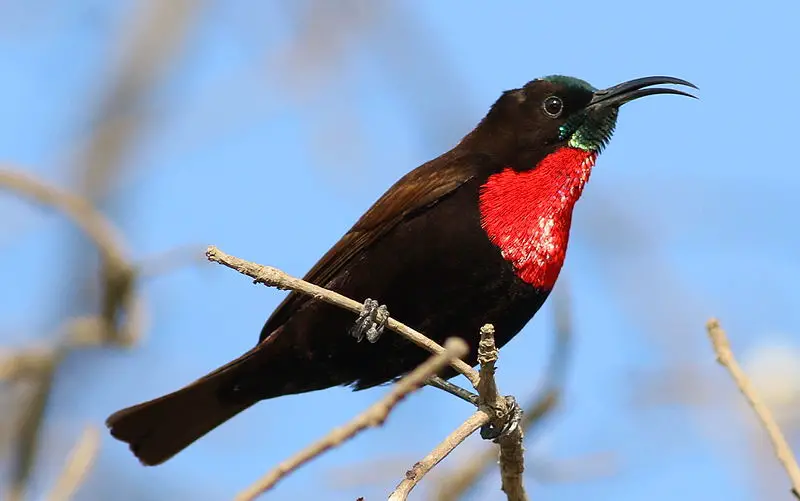
The Scarlet-chested Sunbird is a vibrant species that can be found in many countries across Africa.
It has striking scarlet feathers on its chest, with the rest of its body being mainly black and white.
This bird feeds mainly on insects, but will also feed on fruits, nectar and small lizards if needed. They live in open woodlands or savannas where there are trees to nest and forage from.
During breeding season they gather into pairs and make nests high up in trees made out of twigs lined with soft materials such as downy feathers or plant fibers.
The female lays two eggs which both parents incubate until hatching time comes around after about 2 weeks.
These birds are very social creatures who flock together when food sources become available – making them an enjoyable sight to behold.Scientific classification:
| Kingdom | Animalia |
| Phylum | Chordata |
| Class | Aves |
| Order | Passeriformes |
| Family | Nectariniidae |
| Genus | Chalcomitra |
| Species | C. senegalensis |
Also Featured In: Gambia birds,
31. Yellow-Bellied Elaenia
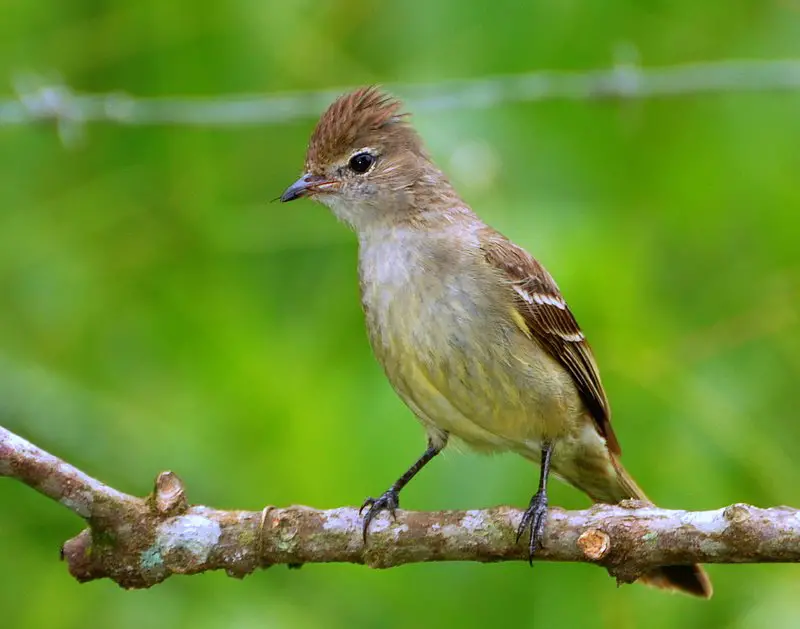
The Yellow-bellied Elaenia is a small bird in the tyrant flycatcher family. It is native to Mexico, Central and South America as well as Trinidad and Tobago.
These birds measure 16.5 cm (6.5 inches) long with an average weight of 24 g (0.85 oz). Their upperparts are olive-brown while their undersides are yellowish which gives them their name ‘Yellow-bellied’.
They have white eye rings, bushy divided crests, and white crown patches on top of their heads that helps identify them easily from other species like it.
The Yellow-bellied Elaenia prefer living near open wooded areas such as forest edges or second growth forests where they feed upon insects by catching them midair or off vegetation surfaces using its beak.Scientific classification:
| Kingdom | Animalia |
| Phylum | Chordata |
| Class | Aves |
| Order | Passeriformes |
| Family | Tyrannidae |
| Genus | Elaenia |
| Species | E. flavogaster |
Also Featured In: Suriname birds,
32. White-Winged Widowbird
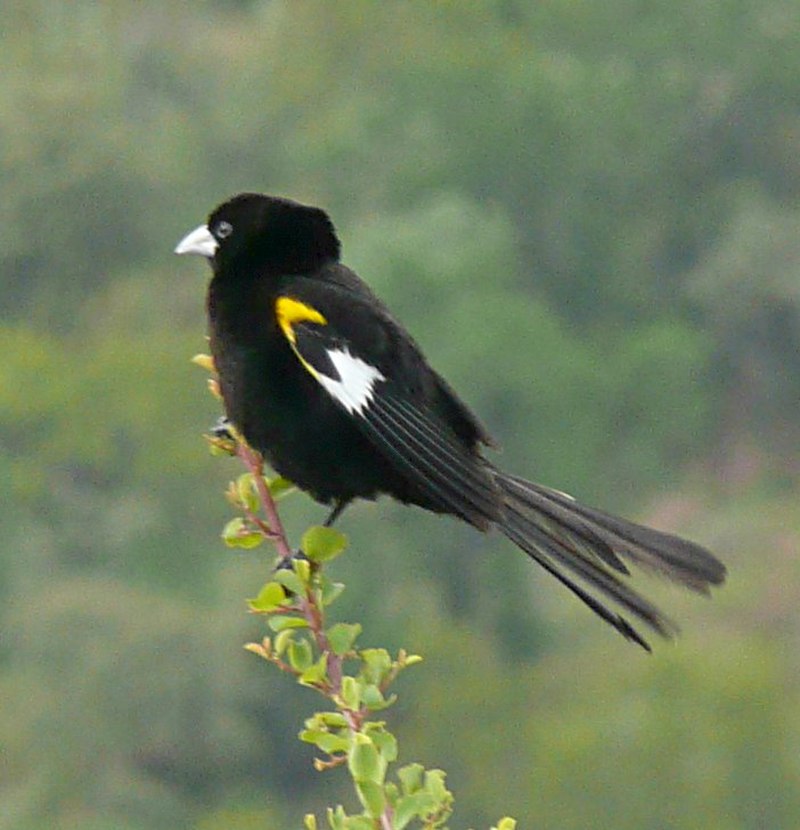
The White-winged Widowbird is a species of passerine bird found in Africa south of the Sahara.
The males have an impressive display during breeding season, with their yellow plumage turning dark and them gaining white feathers – this contrasts to the female’s mostly pale colouration.
There are three recognized subspecies: bicolor, albonotatus and magnovenator.
During mating season, these birds perform spectacular courtship dances that involve leaping into the air while fluttering wings as well as singing complex songs from atop tall perches or telephone wires.
They mainly feed on grass seeds but will also eat insects when available.
Overall they are considered common throughout much of their range due to their adaptability and resilience to environmental changes brought about by human activities like agriculture intensification or urbanization.Scientific classification:
| Kingdom | Animalia |
| Phylum | Chordata |
| Class | Aves |
| Order | Passeriformes |
| Family | Ploceidae |
| Genus | Euplectes |
| Species | E. albonotatus |
Also Featured In: Sao Tome & Principe Birds,
33. Savannah Sparrow
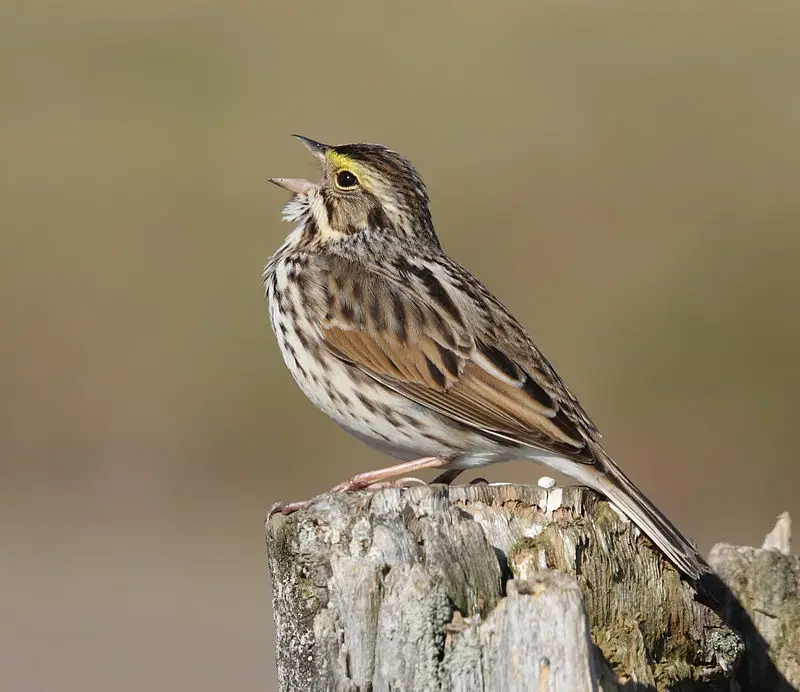
The Savannah Sparrow is a small, New World sparrow. It’s the only bird in its genus, Passerculus and can be distinguished from other similar species by comparing mtDNA NADH dehydrogenase subunit 2 and 3 sequences.
Its closest relative is the Ipswich sparrow which was once considered an independent species but now it’s seen as being part of the same family as this bird.
The male has yellowish-brown upper parts with darker streaks, white underparts with dark streaking on breast and flanks, orange wash to face sides plus two bold wingbars.
Females are slightly duller than males with less distinct markings on wings yet still showing some degree of variation between individuals across their range.Scientific classification:
| Kingdom | Animalia |
| Phylum | Chordata |
| Class | Aves |
| Order | Passeriformes |
| Family | Passerellidae |
| Genus | Passerculus |
| Species | P. sandwichensis |
Also Featured In: Sparrows Species, Birds that Live in the Grasslands
34. Violet-Backed Starling
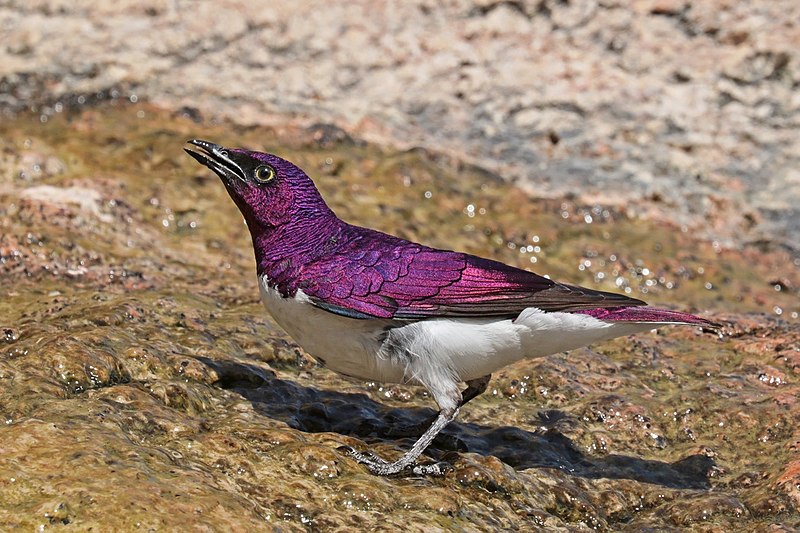
The Violet-backed Starling is a beautiful small bird, with the male sporting a stunning violet back and wings, while the female has an overall grey plumage.
This species of starling can be found in woodlands and savannah forests throughout sub-Saharan Africa.
They are sociable birds that often travel in flocks looking for food such as insects and fruits.
The Violet-backed Starling also forms strong bonds with other members of its flock, so much so that they will even sleep together at night on tree branches to keep warm.
A truly lovely sight to behold if you’re lucky enough to spot one.Scientific classification:
| Kingdom | Animalia |
| Phylum | Chordata |
| Class | Aves |
| Order | Passeriformes |
| Family | Sturnidae |
| Genus | Cinnyricinclus Lesson, 1840 |
| Species | C. leucogaster |
Also Featured In: birds of purple, Birds that You’ll Find in Kruger national park
35. Red-Billed Quelea
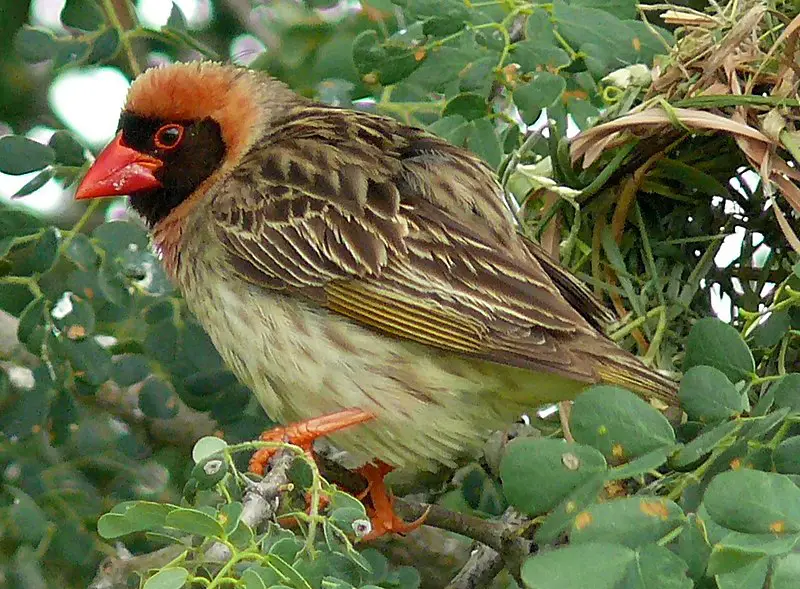
The Red-billed quelea is a migratory bird found in Sub-Saharan Africa. Its small size, approximately 12cm long and 15-26g weight, makes it comparable to a sparrow.
It belongs to the weaver family, Ploceidae, and was named by Linnaeus in 1758, who thought it was a bunting.
Red-billed queleas are known for their bright red beaks and are sometimes called red-billed weavers or red-billed diochs.
These birds are a common agricultural pest, often destroying crops in large flocks. They travel in massive groups of up to several million birds, making them one of the most abundant bird species on the planet.
Despite their status as pests, they are still an important part of the African ecosystem, providing food for predators and are even used as a protein source for humans.Scientific classification:
| Kingdom | Animalia |
| Phylum | Chordata |
| Class | Aves |
| Order | Passeriformes |
| Family | Ploceidae |
| Genus | Quelea |
| Species | Q. quelea |
Also Featured In: Flocks Birds around Us,
36. African Fish Eagle
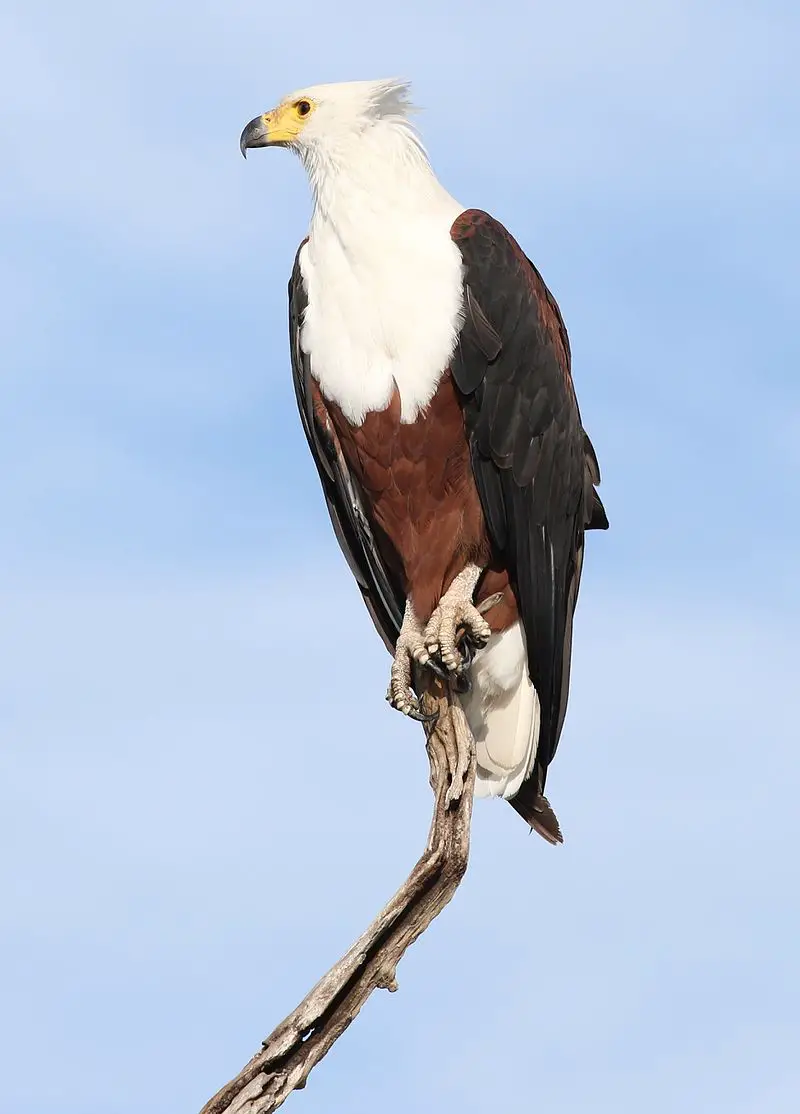
The African fish eagle is a majestic bird of prey found in sub-Saharan Africa near large bodies of water. It is known by many names in different languages due to its extensive range.
This eagle is the national bird of four African countries, including Malawi, Namibia, Zambia, and Zimbabwe.
Its scientific name, Haliaeetus vocifer, is fitting because it has a loud, distinctive call that can be heard from quite a distance.
The African fish eagle’s diet consists mainly of fish, which it swoops down to catch with its talons while in flight.
Its distinctive brown and white plumage, hooked beak, and sharp talons make this a formidable and impressive hunter.
The African fish eagle is an important symbol of African wildlife and is admired by bird watchers and nature enthusiasts for its beauty and strength.Scientific classification:
| Kingdom | Animalia |
| Phylum | Chordata |
| Class | Aves |
| Order | Accipitriformes |
| Family | Accipitridae |
| Genus | Haliaeetus |
| Species | H. vocifer |
Also Featured In: African Birds, East African Birds
37. Common Ostrich
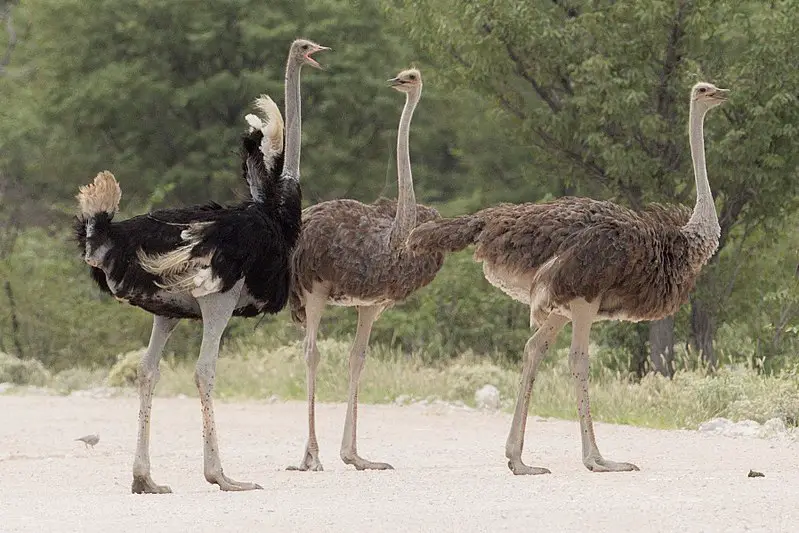
The common ostrich, also known as Struthio camelus, is a flightless bird and the largest living species of bird in the world.
They are native to specific regions of Africa and are the only living members of their genus, Struthio, in the ratite order of birds.
Another ostrich species, the Somali ostrich, is the only other member of the genus Struthio. Common ostriches are known for their long necks and legs, with their wings being too small for flight.
They have an omnivorous diet, feeding on plants, insects, and small animals.
During mating season, males engage in courtship displays and compete for mates, with the females laying their eggs in a communal nest.
These birds are important ecologically and culturally, but they are also threatened by habitat loss and hunting for their meat, feathers, and skin.Scientific classification:
| Kingdom | Animalia |
| Phylum | Chordata |
| Class | Aves |
| Infraclass | Palaeognathae |
| Order | Struthioniformes |
| Family | Struthionidae |
| Genus | Struthio |
| Species | S. camelus |
Also Featured In: Birds that Live in the Deserts, Birds You’ll Find in Zoo
38. Oxpecker
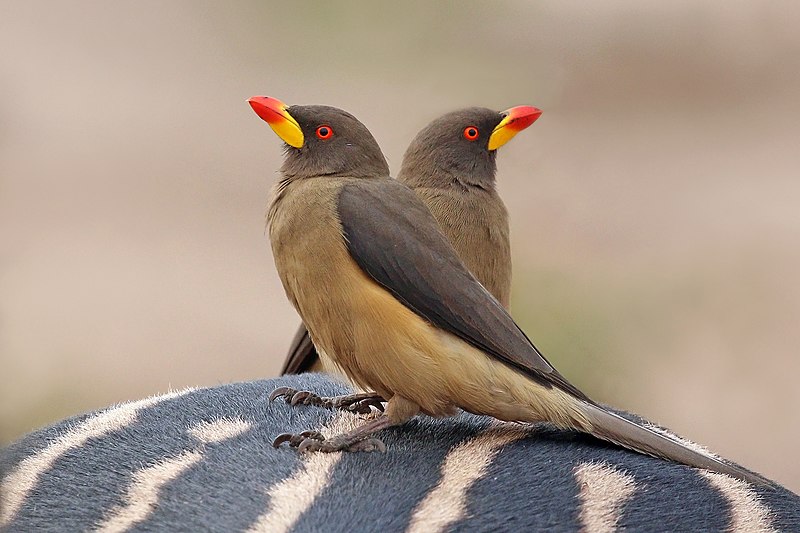
The Oxpecker is a bird species belonging to the Buphagus genus and the Buphagidae family. Unlike what was previously believed, recent molecular studies have shown that these birds form a separate lineage that is different from the starling family.
There are two species of Oxpeckers – the red-billed and the yellow-billed. These birds are commonly found on the backs of large mammals such as rhinoceroses, giraffes, and zebras, where they feed on ticks and other parasites.
The Oxpecker has a unique symbiotic relationship with these animals, as they benefit from eliminating parasites while the host animals benefit from the birds’ grooming activities.
Oxpeckers are also known for their sharp beaks, which they use to access engorged ticks beneath the skin of their host animals.
Despite being a beneficial bird, the Oxpecker’s population is threatened due to habitat loss and over-harvesting.Scientific classification:
| Kingdom | Animalia |
| Phylum | Chordata |
| Class | Aves |
| Order | Passeriformes |
| Superfamily | Muscicapoidea |
| Family | Buphagidae Lesson, 1828 |
| Genus | Buphagus Brisson, 1760 |
39. Ostriches

Ostriches are massive birds that cannot fly. They lay the biggest eggs amongst land animals. These birds are remarkable sprinters, with a top speed of 70 km/h.
They are farmed in several countries, with the Philippines and Namibia being the most significant producers.
Famed for their leather, ostriches are bred for their hides, which are in high demand for their durability and aesthetics.
Their long and thick plumes are often used as decorations or in fashion accessories.
Despite their size, ostriches are primarily herbivores, feeding on shoots, leaves, flowers, and grass. They are social animals and live in groups of up to 50 in the wild.Scientific classification:
| Kingdom | Animalia |
| Phylum | Chordata |
| Class | Aves |
| Infraclass | Palaeognathae |
| Order | Struthioniformes |
| Family | Struthionidae |
| Genus | Struthio Linnaeus, 1758[1] |
Also Featured In: Most Common Nature Birds, Birds of Symbolism
40. Golden-Breasted Starling
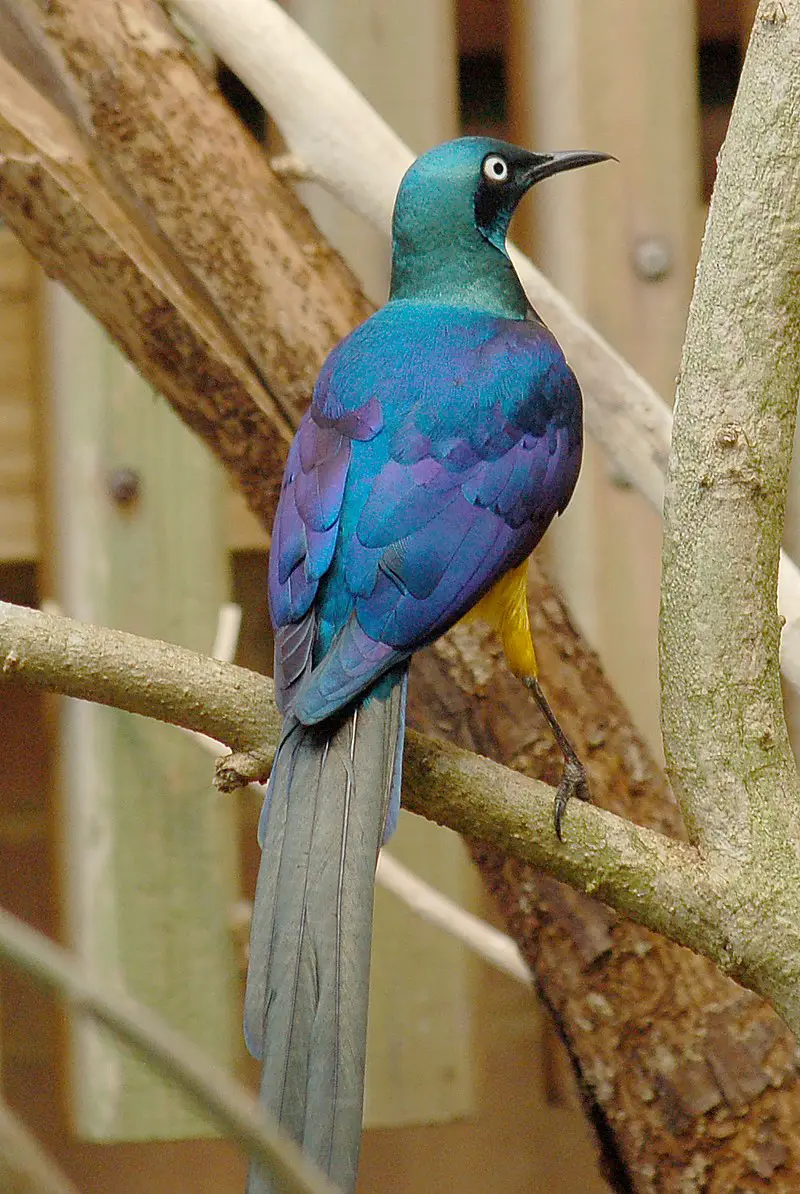
The golden-breasted starling, also known as the royal starling, is a medium-sized passerine that can be found in Northeastern Africa. They inhabit a variety of environments, including grasslands, savannahs, and dry-thorn forests.
With a very large range, they are distributed in countries such as Somalia, Ethiopia, Kenya, and northern Tanzania. These birds have a striking appearance, with a golden breast and blue-black feathers on the rest of the body.
Known for their vocalization abilities, they are skilled mimics and can imitate a variety of sounds in their environment.
The golden-breasted starling plays an important role in the ecosystem as seed dispersers, helping to ensure the continuation of plant species.
Overall, this bird is a valuable and unique part of the avian world in Africa.Scientific classification:
| Kingdom | Animalia |
| Phylum | Chordata |
| Class | Aves |
| Order | Passeriformes |
| Family | Sturnidae |
| Genus | Lamprotornis |
| Species | L. regius |
41. Red-And-Yellow Barbet
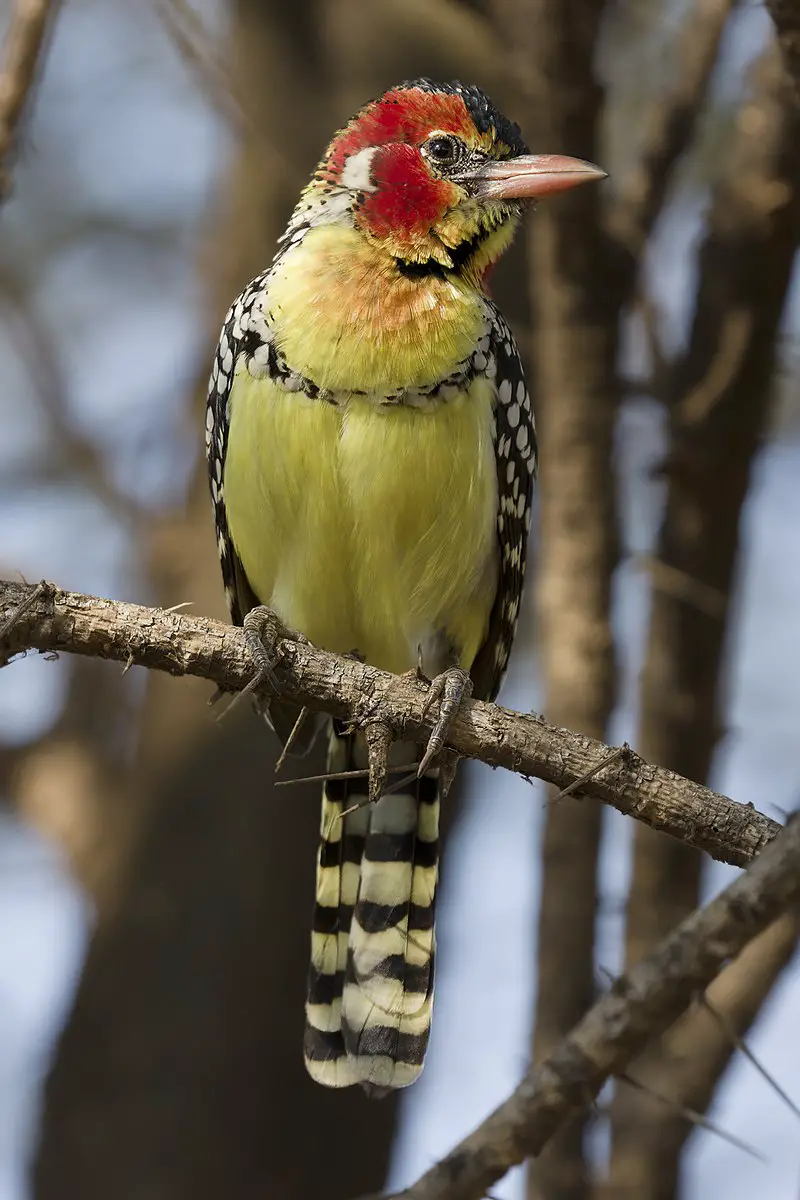
The Red-and-yellow barbet is a beautiful bird species that can be found in eastern Africa. Males are easily distinguished by their black, red and yellow plumage, spotted with white.
Females and young birds are less colorful but bear similarities to the males. This species prefers to live in broken terrains and build nests in burrows. They dine on a diet of invertebrates, seeds, and fruits as omnivores.
As the Red-and-yellow barbet is hunted, their populations are gradually decreasing.Scientific classification:
| Kingdom | Animalia |
| Phylum | Chordata |
| Class | Aves |
| Order | Piciformes |
| Family | Lybiidae |
| Genus | Trachyphonus |
| Species | T. erythrocephalus |
Also Featured In: Birds You’ll Find in Kenya Safari,
42. Red-Cheeked Cordon-Bleu
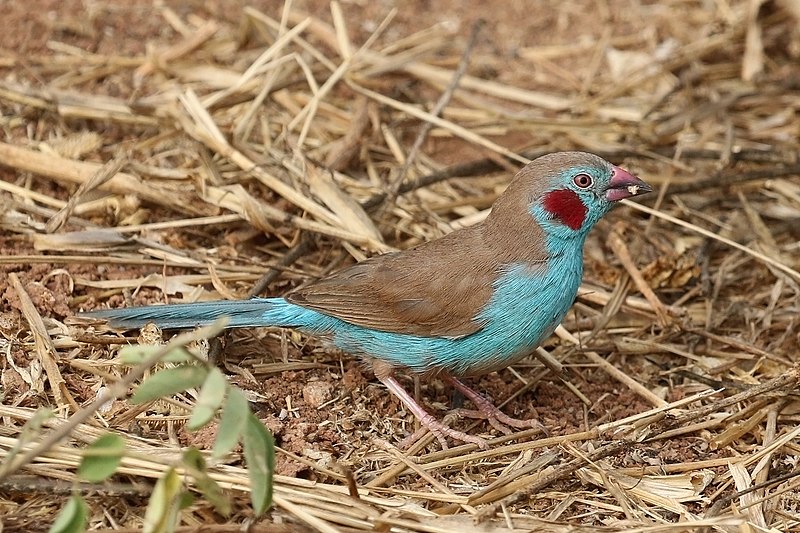
The Red-cheeked cordon-bleu is a petite bird belonging to the family Estrildidae. This species of finch is found in dry regions of tropical Sub-Saharan Africa and is known for its vibrant red cheeks.
It is a resident breeding bird with an estimated global extent of occurrence of 7,700,000 km2.
The Red-cheeked cordon-bleu is a passerine bird, meaning it has three toes facing forward and one backward, allowing it to perch gracefully on branches.
Its diet consists mainly of grains, fruits, and insects. The species was first described by the French zoologist Mathurin Jacques Brisson in 1760, noting its distinct physical features.
The Red-cheeked cordon-bleu is a delight to observe with its colorful plumage and lively movements.Scientific classification:
| Kingdom | Animalia |
| Phylum | Chordata |
| Class | Aves |
| Order | Passeriformes |
| Family | Estrildidae |
| Genus | Uraeginthus |
| Species | U. bengalus |
43. Griffon Vultures
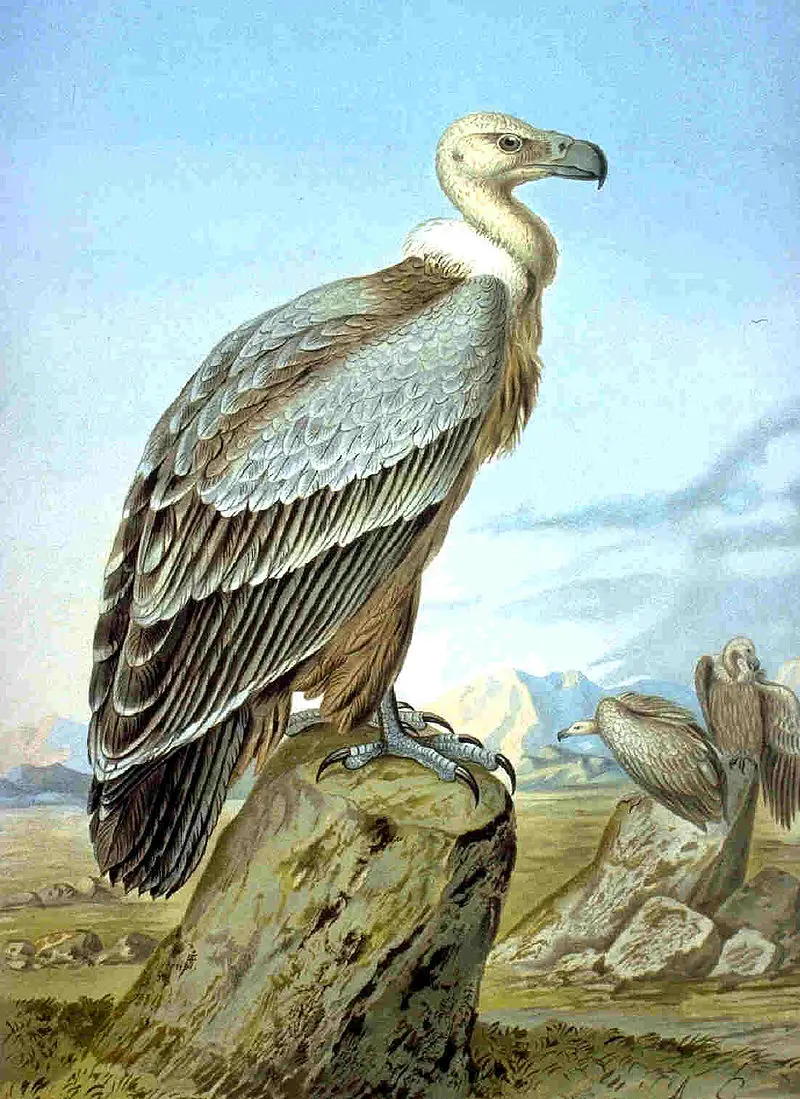
Griffon vultures, also known as Gyps vultures, belong to the Old World vultures family. These birds have long necks with downy feathers and a ruff around their necks formed by buoyant feathers.
Their beaks are big and slightly compressed with dark nostrils set transverse to the beak. These majestic birds have a slim head and are commonly found in mountainous areas. Unlike other birds, they feed on carrion, including dead animals and their bones.
Griffon vultures play a vital role in the ecosystem as they help in the natural process of reducing waste and preventing the spread of diseases.
However, their population has decreased significantly due to human activities such as poisoning, hunting, and loss of habitat.
Several conservation organizations are working towards protecting these magnificent birds and preserving their populations for future generations.Scientific classification:
| Kingdom | Animalia |
| Phylum | Chordata |
| Class | Aves |
| Order | Accipitriformes |
| Family | Accipitridae |
| Subfamily | Aegypiinae |
| Genus | Gyps Savigny, 1809 |
Also Featured In: Scavengers Birds You Should Know,
44. Golden-Capped Parakeet
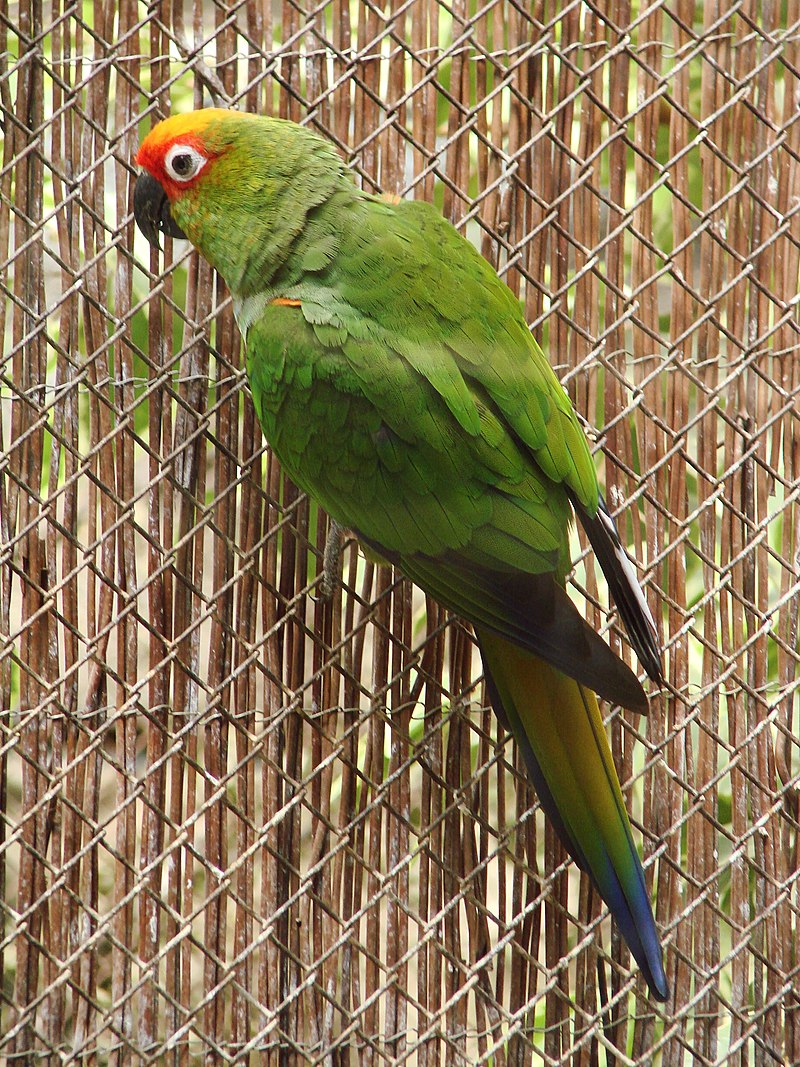
The Golden-capped parakeet, also known as Aratinga auricapillus, is a species of parrot that is commonly found in Brazil and Paraguay. It is a small bird that is often seen in subtropical and tropical environments, such as dry forests and lowland forests.
Unfortunately, the species is threatened by habitat loss due to deforestation caused by human activities.
Despite its vulnerability, the Golden-capped parakeet is a good biological indicator because of its high detectability in the wild. This bird is known for its distinctive golden-yellow crown and bright green coloring.
It is an important species for maintaining the balance of the ecosystem and should be protected to ensure its survival for future generations.Scientific classification:
| Kingdom | Animalia |
| Phylum | Chordata |
| Class | Aves |
| Order | Psittaciformes |
| Family | Psittacidae |
| Genus | Aratinga |
| Species | A. auricapillus |
45. Burnished-Buff Tanager
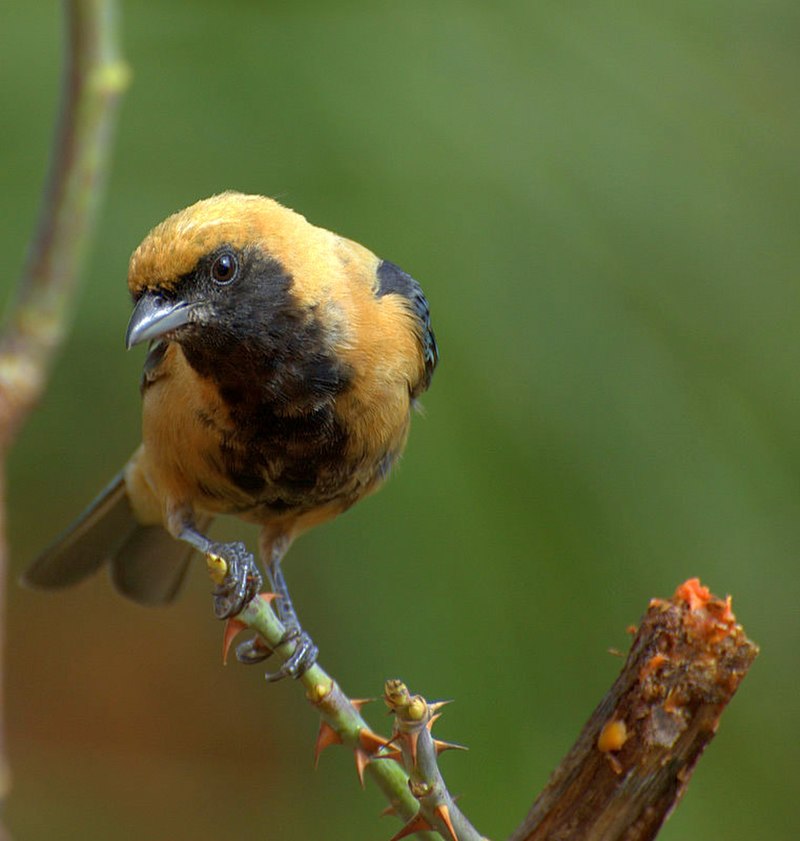
The Burnished-buff Tanager, also called the Rufous-crowned Tanager, is a bird commonly found in South America.
This bird is a member of the Thraupidae family and has a striking appearance, with its burnished-buff feathers.
The bird’s range spans across the northern Guianas, much of Venezuela, east-central Colombia, and parts of Brazil, Paraguay, and northeast Argentina. Although it’s common in some regions, it’s only localized in Bolivia.
This bird prefers to dwell in wooded areas and is particularly found in forest edges and clearings.
The Burnished-buff Tanager is a beautiful bird that has distinctive characteristics that set it apart from other birds.
It’s an excellent sight for bird-watchers and nature enthusiasts who enjoy observing its unique features and listening to its songs.
Although the Burnished-buff Tanager’s population is stable, it’s still threatened by habitat loss, and its conservation is crucial to preserving its species.Scientific classification:
| Kingdom | Animalia |
| Phylum | Chordata |
| Class | Aves |
| Order | Passeriformes |
| Family | Thraupidae |
| Genus | Stilpnia |
| Species | S. cayana |
46. Buteogallus
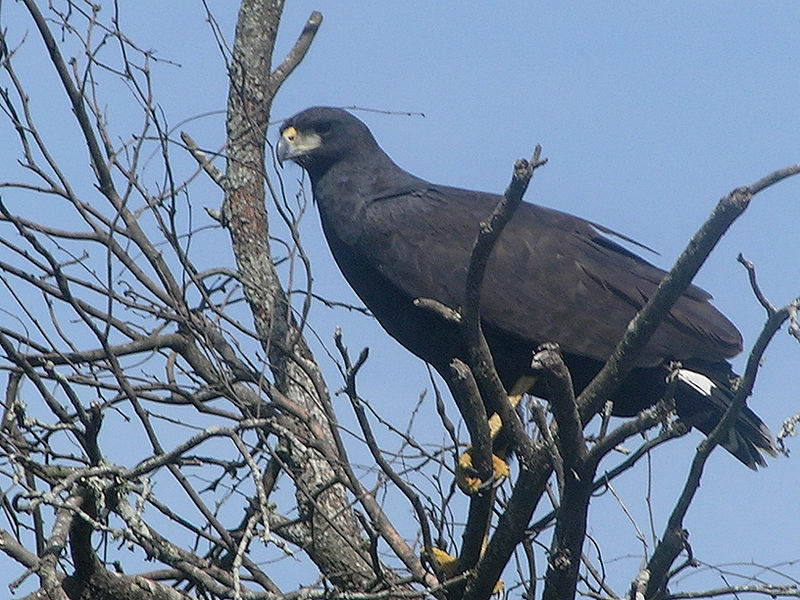
Buteogallus is a group of birds of prey from the family Accipitridae. They are primarily found in the neotropics, except for one species that also inhabits the southwestern part of the United States.
These birds have a diverse range of habitats, but many of them are attracted to large crustaceans and can be found walking along the banks of rivers and shorelines to hunt for this type of prey. While some species have a coastal lifestyle, others have a different way of life.
They are equipped with sharp talons and keen eyesight, making them excellent hunters. The Buteogallus species are known for their size and strength, allowing them to take down larger prey.
Overall, Buteogallus is a fascinating group of birds that occupy various niches in their ecosystems.Scientific classification:
| Kingdom | Animalia |
| Phylum | Chordata |
| Class | Aves |
| Order | Accipitriformes |
| Family | Accipitridae |
| Subfamily | Buteoninae |
| Genus | Buteogallus Lesson, R, 1830 |